This article contains affiliate links. We may receive compensation if you make a purchase at no additional cost to you.
Rome Food Favorites: 26 Must Eat Dishes
Discover 26 must-eat Rome food favorites that you simply should not miss during a food-focused trip to the Eternal City.
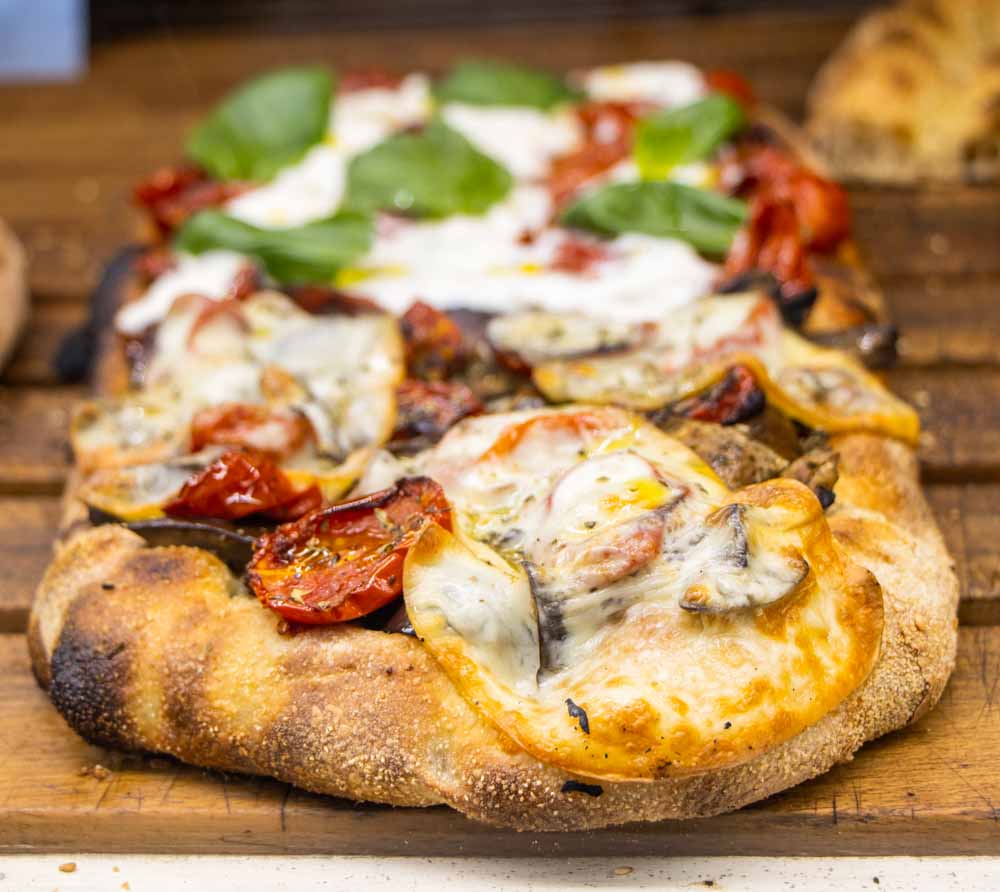
Rome holds a special place in our hearts. It was the first Italian city we visited together and Daryl’s introduction to eating in the food paradise known as Italy. Upon our arrival, we were greeted by rain as we entered the ancient city inundated by robed clergy in town for a bishop’s funeral.
We still remember lounging over a bottle of luscious local red wine at a dark enoteca in Trastevere, surrounded by aspiring men of the collar, waiting for the steady rain to end to begin our Rome exploration. Instead, the steady rain became a deluge. We ordered another bottle of wine and went for pizza instead.


As stereotypical American travelers, we packed everything into that initial visit just in case we never made it back to Europe. There was no rest for the weary as we traversed the city to see sites like the Vatican, Colosseum, Pantheon, Forum and Galleria Borghese.
That initial Rome trip was the start of an ongoing love affair that has brought us back to the eternal three more times and counting. And, while we love Rome’s famous sites, we keep returning to eat our Rome food favorites.
What To Eat In Rome
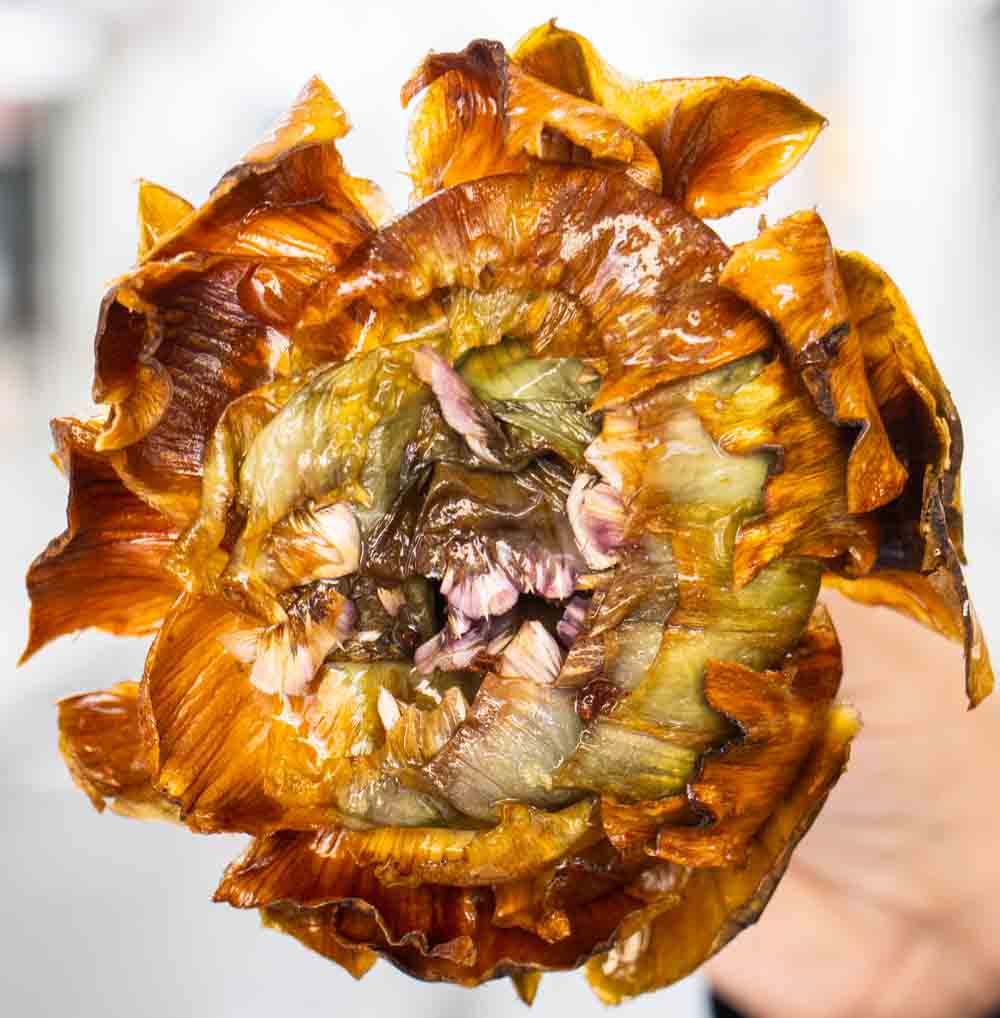

While travelers regularly seek out pizza and gelato as part of their Roman adventure, most people bump into dishes like Cacio e Pepe by accident or while on a Rome food tour.
We cry foul to this approach. There are certain foods that you must eat in Rome or you’ll be missing out on the full Rome food experience. We also get that eating all the food requires effort.
Rome is a big city filled with culinary jewels honed over two millennia. Many of the best places to eat in Rome require advance reservations, making spontaneity moot for those looking to eat well during their vacations.
Wondering where to eat in Rome? Discover our favorite restaurants in Rome and don’t forget to make reservations.
We’ve done the research. We’ve eaten the food. We’ve imbibed the drinks. And now we’re writing this Rome food guide to prepare you for your Roman culinary adventure.
In other words, these are the 26 things you must eat and drink when you visit Rome:
Roman Pasta
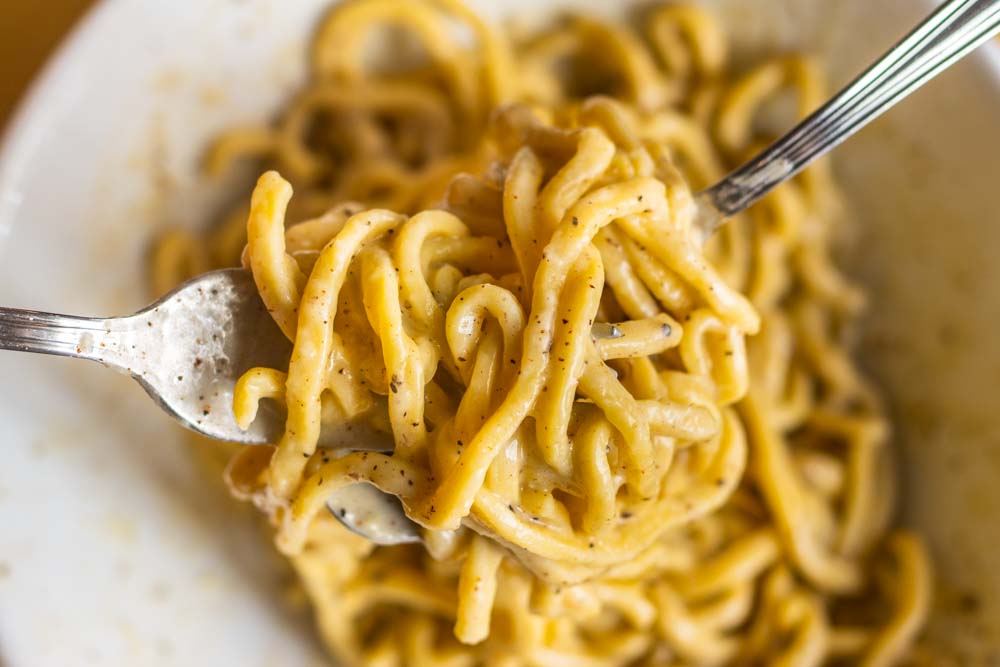

Rome’s Lazio region isn’t the only Italian region with unique pasta dishes. In Emilia-Romagna, fresh ribbon pastas and meaty ragus hold court while thick spaghetti-like bigoli pastas share the menu with rich risottos in inland Veneto cities like Verona. Further south in Naples, diners regularly eat rustic pastas topped with onion-laden Genovese sauce.
Discover the best noodles in Italy and beyond.
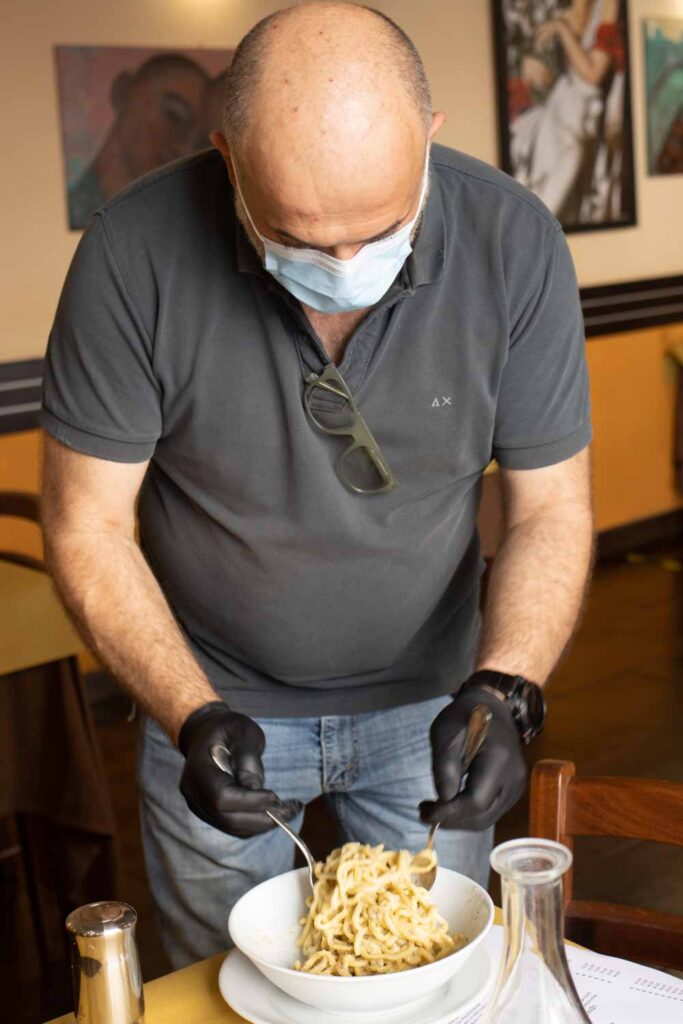

Roman menus are the most homogeneous in all of Italy with most trattorias serving the city’s holy quadrinity – cacio e pepe, carbonara, amatriciana and gricia. Though these Roman pastas have all achieved global fame, they remain as popular as ever in Rome. Then there’s fettuccine Alfredo, Rome’s most misunderstood pasta dish.
Each one of Rome’s iconic pastas is a celebration of culinary simplicity and precision. Done well, these creamy, flavorful, tomatoey, porky, cheesy pastas can be life changing. Eating one or more is a must in Rome. In fact, it will probably be your best lunch in Rome unless it’s your best dinner instead.
1. Cacio e Pepe
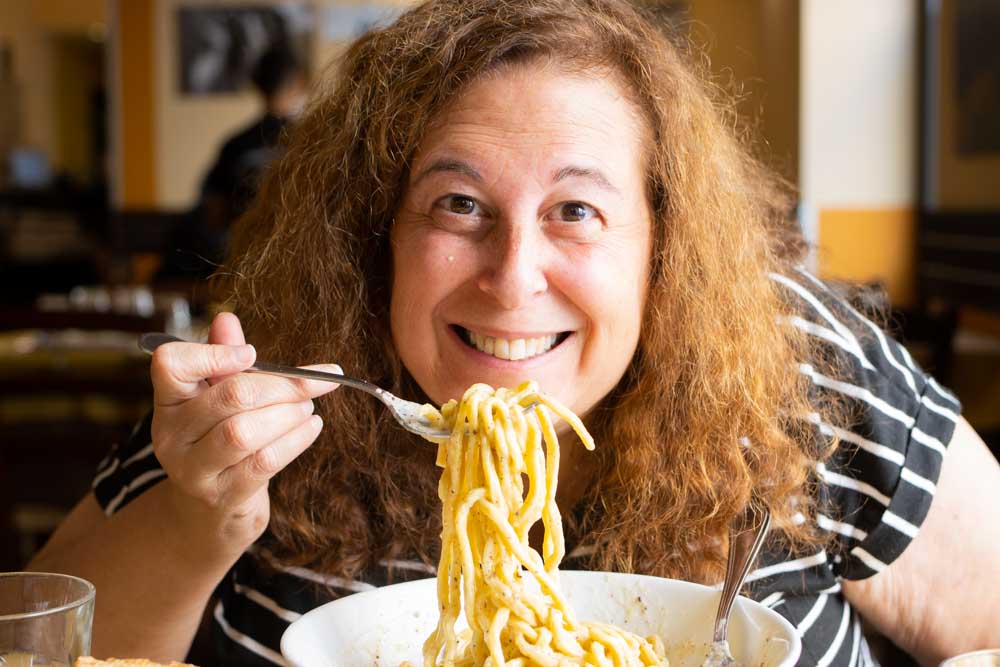

Cacio e pepe translates to cheese and pepper and that’s exactly what’s in Rome’s most famous pasta. Besides black pepper and pecorino Romano cheese, the only other cacio e pepe ingredients are pasta and salt. In Rome, thick, fresh, spaghetti-like strands of tonnarelli marry the dreamy mix together like nowhere else.
Learn how to cook Cacio e Pepe at home.
Don’t underestimate cacio e pepe based on its short list of ingredients found in every Italian kitchen. The combination of freshly ground black pepper and salty pecorino cheese is a synthesis of local ingredients that cooks have ‘on hand’. It’s a masterpiece of kitchen craftsmanship where starchy pasta water, salty pecorino and earthy pepper combine to make a dish that’s better than sum of its parts.
Where to Eat Cacio E Pepe in Rome
Rome is a big city and you’ll find fine pasta throughout the city. We’ve eaten excellent versions at both Roscioli Salumeria and Piatto Romano as well as at a pasta stall in Rome’s Testaccio market
2. Carbonara
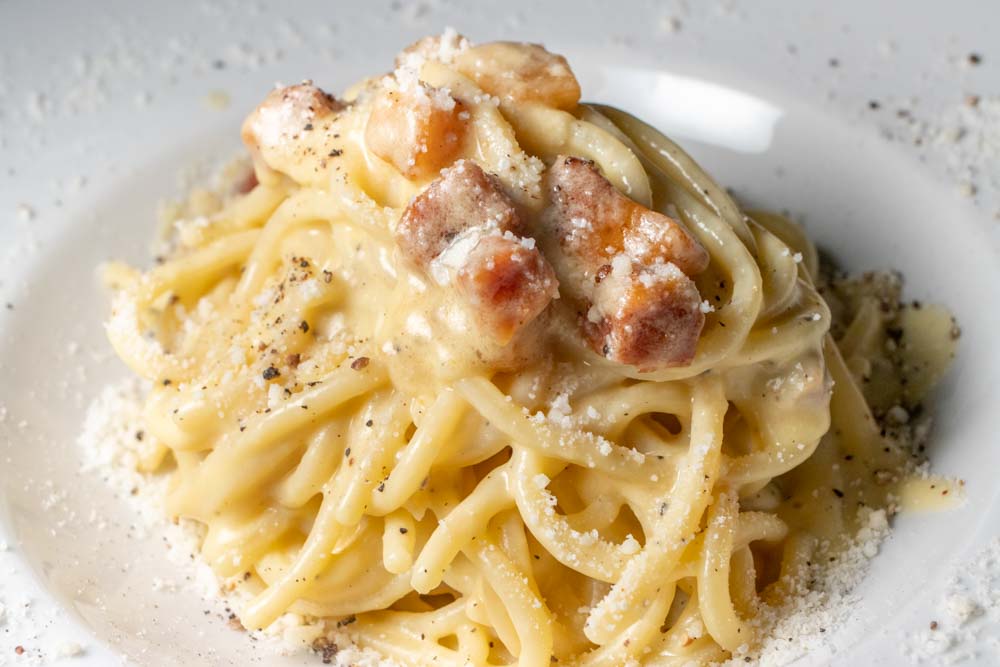

The origin of pasta carbonara is much disputed. Did it originate with coal workers who ate the eggy pasta? Was the name inspired by black coal-like flecks of pepper that contrast the dish’s yolky, creamy sauce? Or was it inspired by the Roman curiosity over WW2 American soldiers’ penchant for bacon and eggs?
Learn how to cook linguine carbonara at home.
Though we’ll never be sure about its origin, we can be certain that making great pasta carbonara is an art. The richness of the dish’s golden sauce comes solely from a combination of egg yolk, fatty guanciale pork fat, starchy pasta water and salty, sheepy pecorino Romano cheese.
While some heretics add heavy cream for good measure, the trick is to emulsify eggs yolks without letting them break. Expert chefs at Rome’s best restaurants do this well.
Where to Eat Carbonara in Rome
See Cacio e Pepe above.
3. Amatriciana
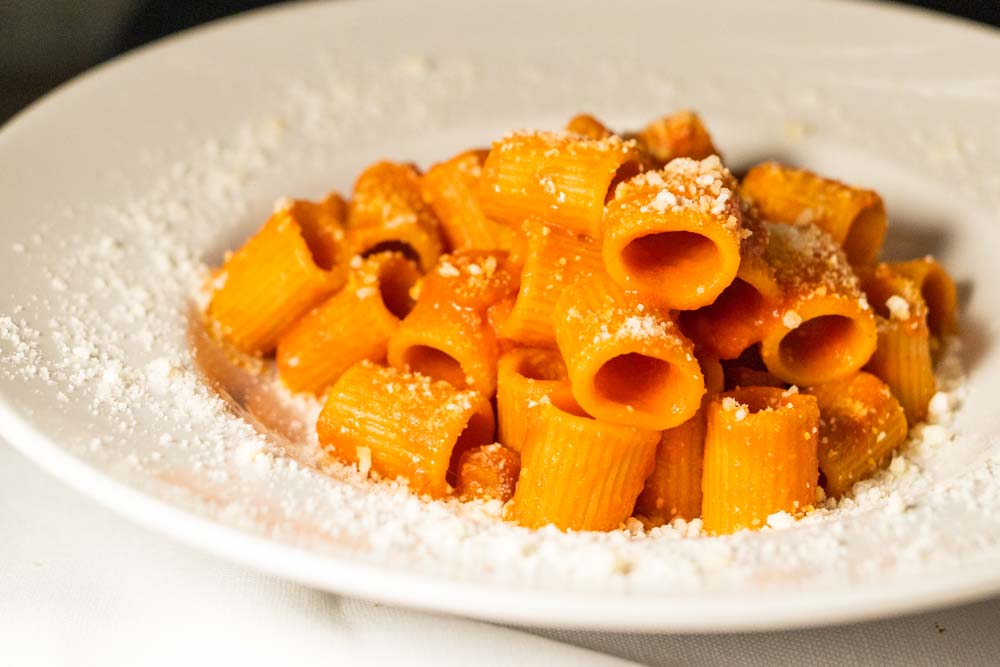

Hailing from the outer Lazio village of Amatrice east of Rome, pasta amatriciana unites tomatoes with guanciale. It’s also the answer to how to take something good – pasta alla gricia (see below) – and make it better.
A great Amatriciana sauce is all about flavor. In this dish, rich, umami-filled, gamey, slightly caramelized pork fat receives a sweet, acidic kick from tomato sauce and (occasionally) onions.
Learn how to cook rigatoni amatriciana at home.
We enjoyed amatriciana with two different pastas during our most recent visit to Rome. We ate the dish with mezze manica, a slightly smaller version of rigatoni, at Salumeria Roscioli and with spaghetti at Piatto Romano in Testaccio.
Where to Eat Amatriciana in Rome
See Cacio e Pepe above.
4. Gricia
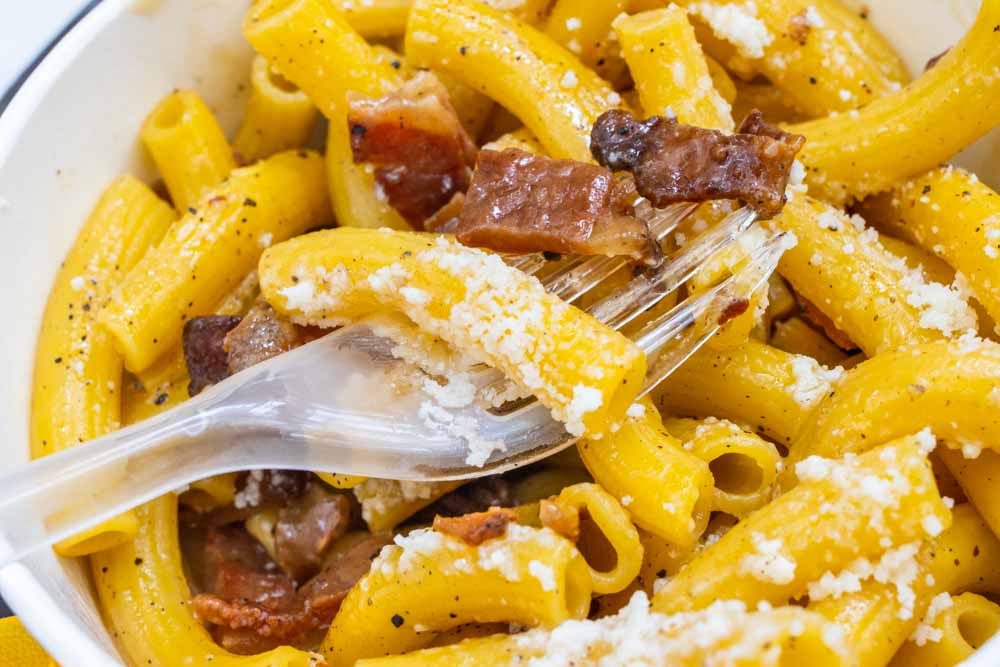

Dishes like gricia first made their appearance in the Roman pasta ouvre in the 1300s. We’d like to think that tomatoes grew in Italian fields filled with grazing unicorns back in the day; however, history reveals that neither tomatoes nor unicorns existed in Italy prior to the Columbian expansion.
There are no onions in gricia, no garlic and, obviously, no tomatoes. Gricia is just guanciale, pepper and pasta. Yes, it’s topped with grated pecorino Romano, but the cheese, unlike in cacio e pepe, is a last minute finish to the dish as opposed to a key ingredient.
Learn how to cook Pasta alla Gricia at home.
In gricia, starchy, salty pasta water combines with the rendered pork fat to create a saucy emulsion. Its simple medley of flavors is the pasta equivalent of a bacon sandwich and doesn’t work unless the pasta and the pork are of top quality. Fortunately there’s plenty of great pasta and pork in Rome.
Where to Eat Gricia in Rome
See Cacio e Pepe above.
5. Fetticcine Alfredo


Fettuccine Alfredo in America is often gloopy but it doesn’t have to be that way. After all, it’s an Italian dish born in Rome. And, yes, there was actual person named Alfredo and a restaurant with his name which is where the dish became famous.
Ironically, though,, Alfredo di Lelio, who famously served the buttery, cheesy pasta in the early 20th century, didn’t actually invent the dish – its origin can be traced to the 15th century. Back then, the dish likely had a different name, perhaps fettuccine al burro (i.e. fettuccine with butter).
Learn how to cook fettuccine Alfredo at home.
Alfredo is more than pasta with butter. Its recipe also includes Parmigiano-Reggiano cheese. Some American recipes add ingredients like egg yolk and heavy cream. However, you won’t miss those extra ingredients when you eat the decadent pasta in Rome in the way that it was intended to be eaten.
Where to Eat Fettuccine Alfredo in Rome
Alfredo alla Scrofa
Roman Pizza
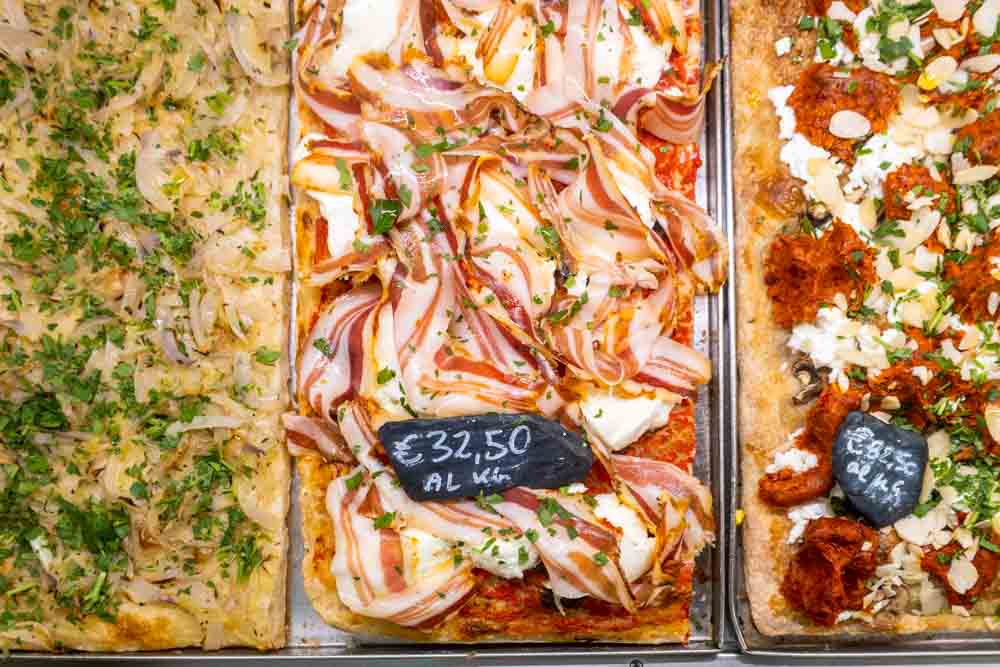

Proving that not all pizzas are created equally, pizza in Rome is its own thing. Unlike supple, round Neapolitan pies and ginormous New York slices, Roman pizza comes in all shapes and sizes.
Most people prefer one type of pizza over the others. While we rarely meet (and eat!) a pizza we don’t like, we fall into the Naples camp. However, we ate a lot of pizza in Rome just to be sure.
Read our comprehensive pizza guides for Naples and Rome.
When you take your own personal Rome pizza tour, be sure to try both pizza al taglio and pizza Romano. Keep reading for a description of each Roman pizza style.
6. Pizza al Taglio
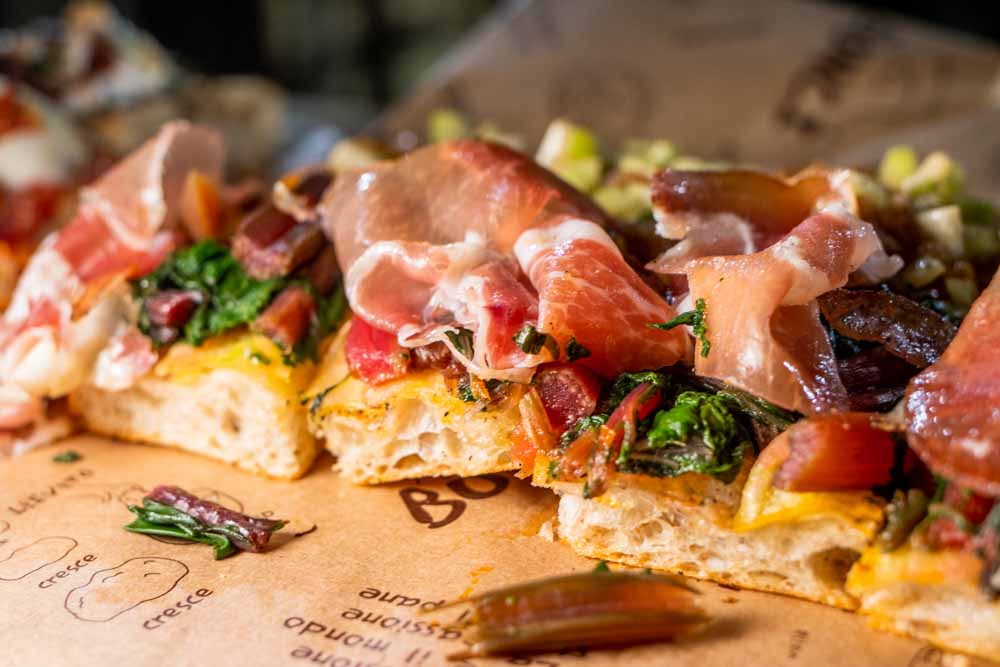

A Rome cheap eats favorite and a great snack to eat on the go, pizza al taglio reminds us of loaded focaccia. You won’t have to look hard to find these rectangular slices in Rome. Shops and stalls sell pizza al taglio all over the city.
Pro Tip
While some vendors sell pizza al taglio for a fixed price, most calculate the price based on weight. Since Italy, like the rest of the European Union, uses the metric system, the listed price is typically per kilogram.
Pizza al taglio literally translates to sliced pizza. This Roman style of thick square pizza is always sliced and often served by weight. Typical toppings include tomatoes, salumi, herbs and all sorts of vegetables.
Where to Eat Pizza al Taglio in Rome
Antico Forno Roscioli, Forno Campo de’ Fiori, Pizzarium Bonci and Pizzeria La Boccaccia
7. Pizza Romano
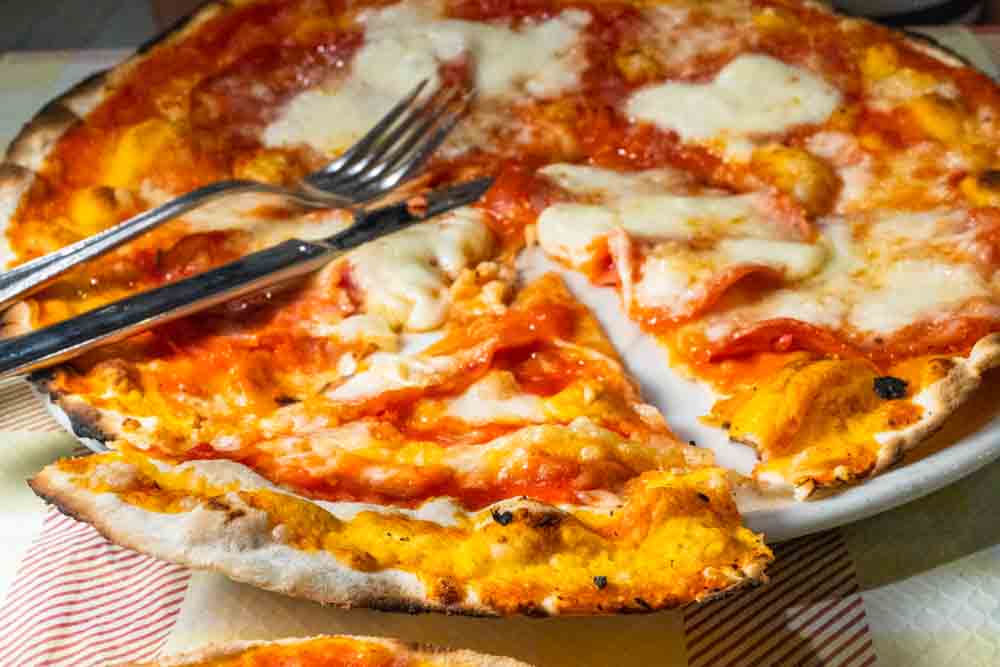

Pizza Romana, or Roman-style pizza, is cracker thin, crispy and crunchy. In many ways, it’s the exact opposite of the best Neapolitan pizza which is both supple and soft. The two pizza types meet in the middle when it comes to toppings like cheese, artichokes and sausage since both Rome and Naples have ready access to some of the best food products in the world,
Plan to sit down when you eat pizza Romana in Rome. You’ll want to start your meal with a suppli or another fried treat before you dig into your big, round, individual pie. Be sure to order a jug of wine since Rome is in Italy after all.
Where to Eat Pizza Romano in Rome
Ai Marmi, Li Rioni a Santiquattro, Pizzeria Baffetto and Pizzeria da Remo
Traditional Roman Food
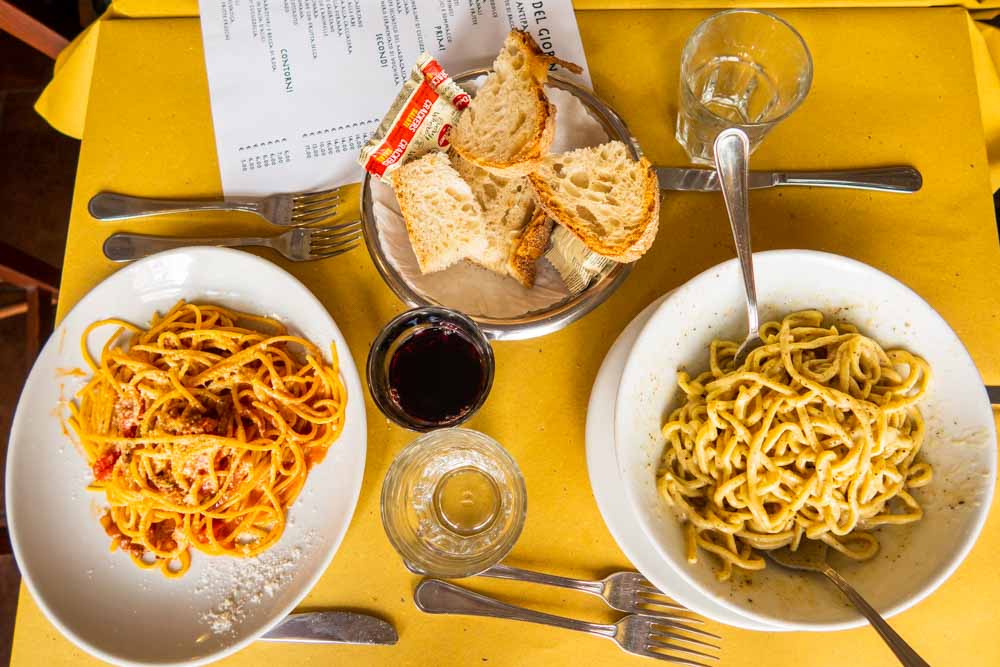

It would be super easy to just eat pasta and pizza in Rome but that would be a shame. Roman restaurants offer great primi (appetizer) and secondi (main course) options that don’t involve either noodles or crust.
When you’re ready to dip your toes into the deep water of traditional Roman cuisine, we recommend starting with the following classic dishes:
8. Carciofi alla Giudìa (Roman-Style Artichokes)
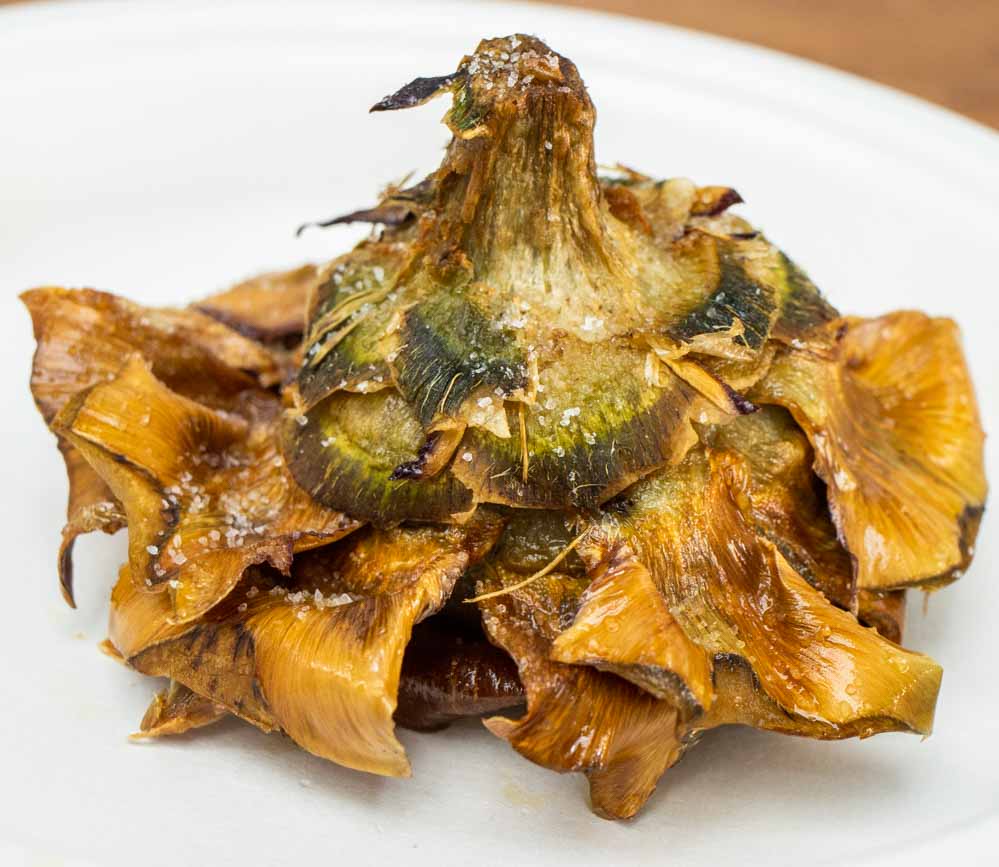

Named after Roman Jews who invented the dish in Rome’s Jewish Ghetto, the carciofi alla giudìa is a deep-fried artichoke that almost looks too pretty to eat. But eating the seasoned thistle flower is the thing to do when the opportunity arises.
Roman chefs prepare carciofi alla giudìa with artichokes grown near the city. Although peak artichoke season in the region is from February to April, we’ve had no problem finding the crispy classic in autumn months.
Where to Eat Carciofi alla Giudìa in Rome
Da Enzo, Flavio al Velavevodetto, La Matricianella, Nonna Betta and Ristorante Piperno
9. Trippa alla Romana
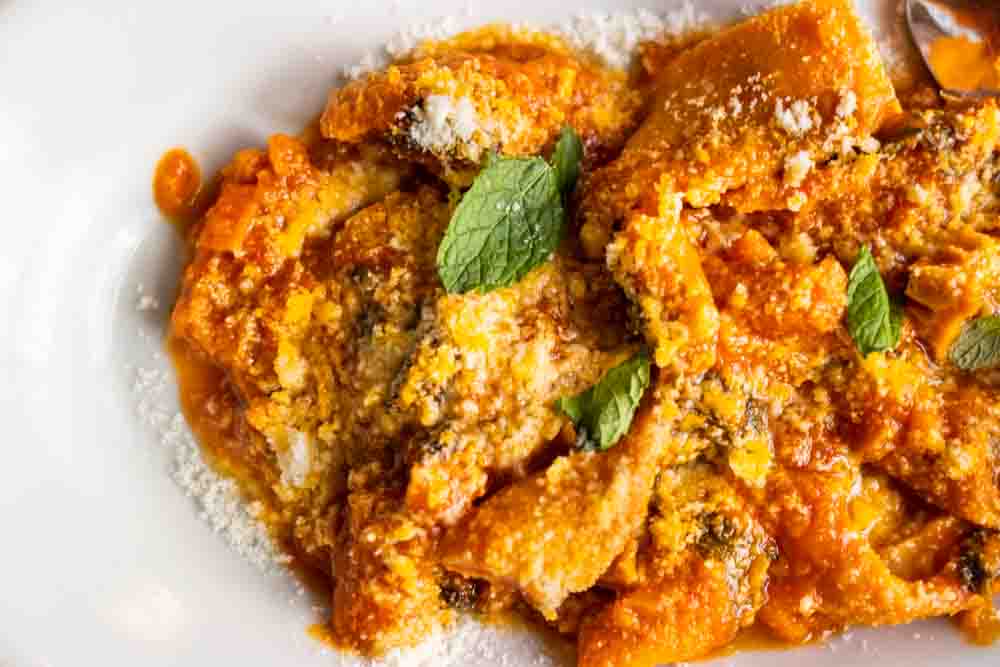

Tripe is one of those foods that most people either love or hate. Well, to be clear, most people are afraid to eat tripe since they can’t ‘stomach’ the idea of eating the stomach lining from a cow, pig or sheep. We urge you to conquer this fear when you dine in Rome. Otherwise, you’ll miss out on one of the most classic of Roman dishes.
Tripa alla Romana is a dish of poverty that peasants ate back in the day when they couldn’t afford better cuts of meat. To compensate for the tripe’s chewy texture, they cooked the offal low and slow in a tangy tomato sauce laden with onion, garlic and the occasional red pepper flake.
Grated cheese completes trippa alla Romana. Since it’s a Roman dish, the cheese of choice is pecorino Romano. Any other cheese would just be wrong.
Where to Eat Trippa alla Romana in Rome
Armando al Pantheon, Da Enzo, Checchino Dal 1887, Flavio al Velavevodetto and Piatto Romano
10. Saltimbocca alla Romana
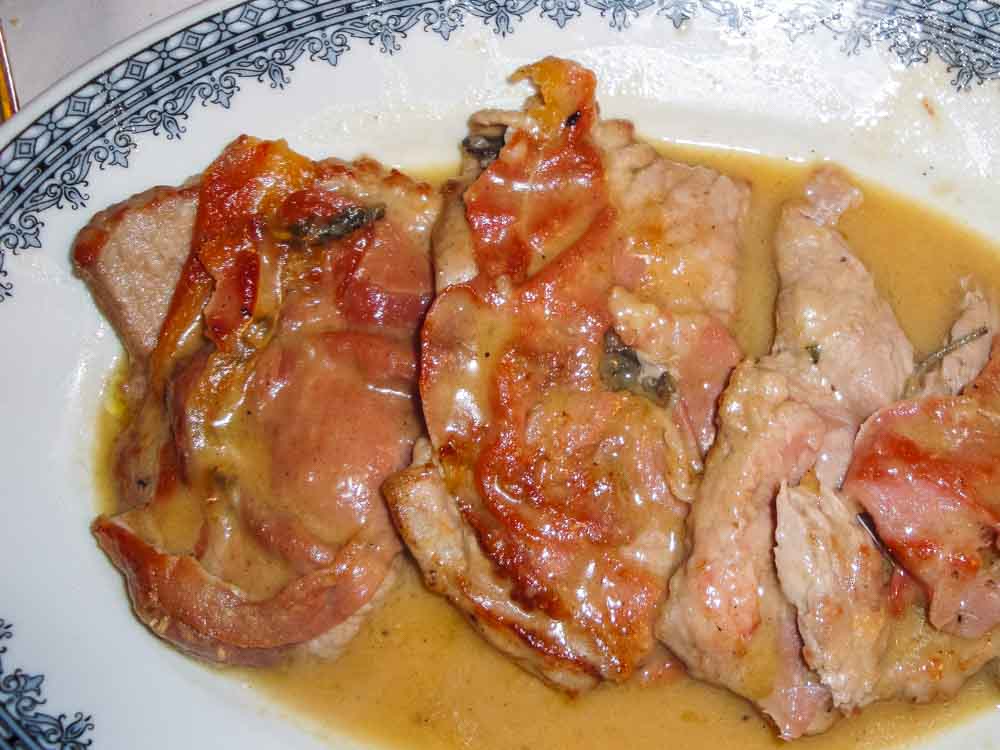

The Italian word saltimbocca literally translates to jump in the mouth and that’s precisely what we want this dish to do whenever it hits our table. In Rome, the dish is called saltimbocca alla Romana and it’s a show stopper.
Chefs have been wrapping pounded veal in prosciutto and sage and then cooking it in a wine and butter sauce for more than a century. The combination of salty prosciutto and aromatic sage elevates the veal while the buttery wine sauce makes it sing.
Where to Eat Saltimbocca alla Romana in Rome
Restaurants like Ristorante Piperno and Trattoria Al Moro
Rome Cheap Eats + Rome Street Food
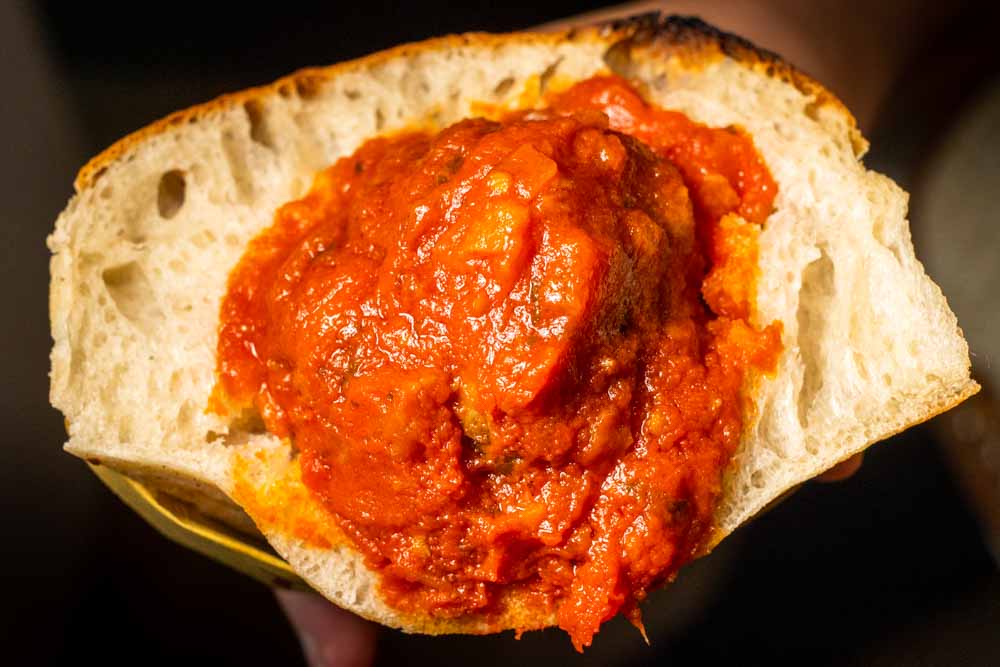

Pizza may be Rome’s cheap eats favorite, but the city has a plethora of other tasty treats for bargain hunters, junk food junkies and street food devotees. If you fit into any or all of these categories, we recommend that you hit the ground running in Rome by eating the following:
11. Suppli
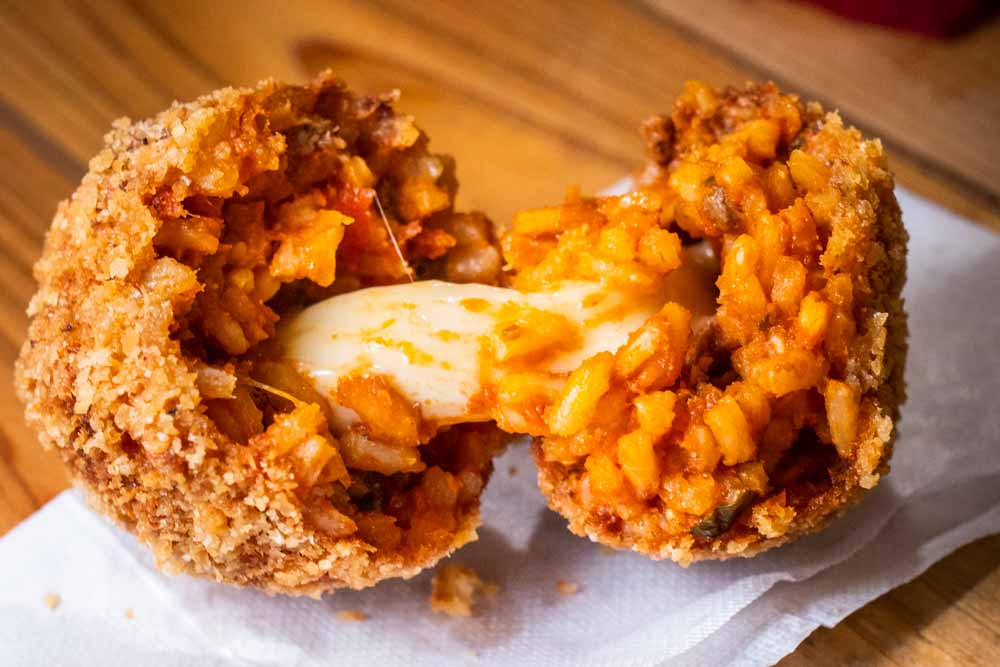

Friggitorias are happy places in Italy for those who like to snack on fried street food. In Naples, friggitorias sell fried pasta balls called frittatina. Sicilian friggitorias sell fried rice balls called Arancini. But what’s the specialty at Rome’s friggitorias?? That answer is an easy one – suppli is the #1 Roman street food.
Pro Tip
Don’t feel left out if you’re not a street food eater. You can also eat a suppli or two at Roman pizzerias and neighborhood markets. In other words, you don’t have to eat the best street food in Rome while standing or walking.
At first glance, a suppli looks like an arancini. The similarities don’t stop with appearance as both croquette-shaped treats have rice inside. However, the suppli has two extra bits – gooey cheese and tomato sauce. And, yes, this Rome street food favorite is just as delicious as you suspect.
Where to Eat Suppli in Rome
Pizzarium Bonci and Trapizzino
12. Trapizzino
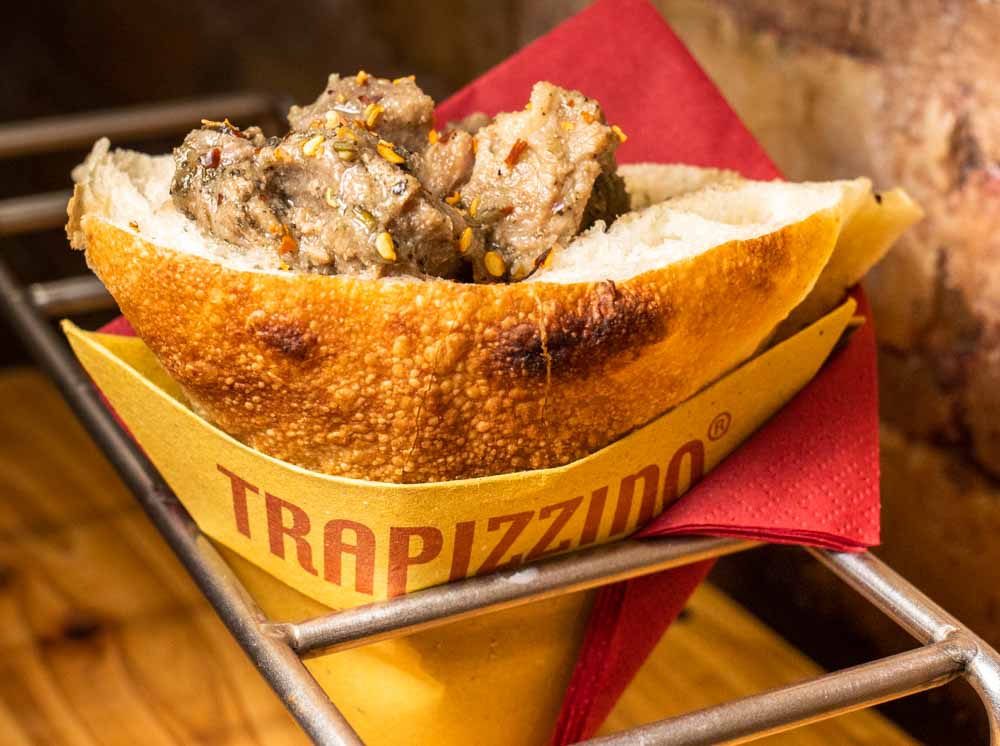

Many of Rome’s most popular foods have long and storied histories. The Trapizzino is not one of those foods. Invented by Roman pizzaiolo Stefano Callegari in 2008, the Trapizzino is a relative baby… but don’t count it out.
A hybrid of two local food favorites (Roman pizza and tramezzino sandwiches), Callegari’s culinary creation is a pizza dough cone stuffed with savory Roman food typically served on a plate. Its shape makes it uniquely portable while its ingredients attract crowds at Trapizzino’s half dozen locations around Rome and beyond.
Familiar fillings include trippa alla Romana (Roman tripe), parmigiana di melanzane (eggplant parmigana) and polpetta al sugo (meatballs in tomato sauce). More exotic fillings like Ethiopian zighni flavored with berberé spice are equally enjoyable.
Where to Eat a Trapizzino in Rome
Trapizzino
13. Tramezzino
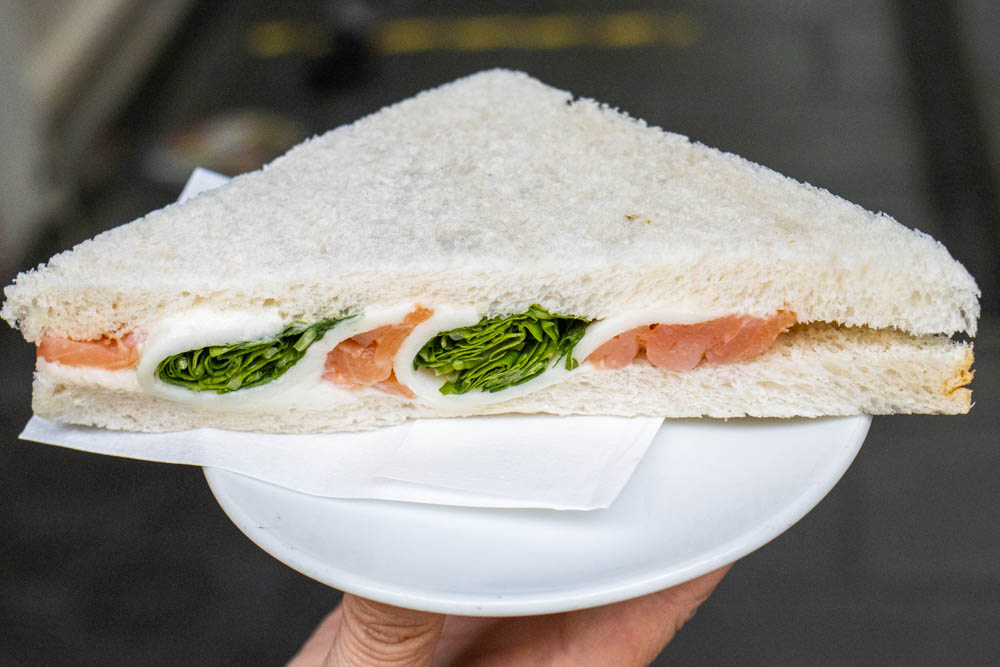

Although the tramezzino was invented more than 400 miles away in Turin, the triangular, crust-free sandwich is easy to find at cafes and bars in Rome. Typical fillings include tuna, egg salad and salumi.
This Roman cheap eat is a great mid-morning or late afternoon snack between meals and can be paired with either coffee or beer. It’s a particularly good option for vegetarians who can order tramezzini filled with olives or cheese.
Where to Eat Tramezzini in Rome
Markets, Cafes and Snack Shops
14. Porchetta
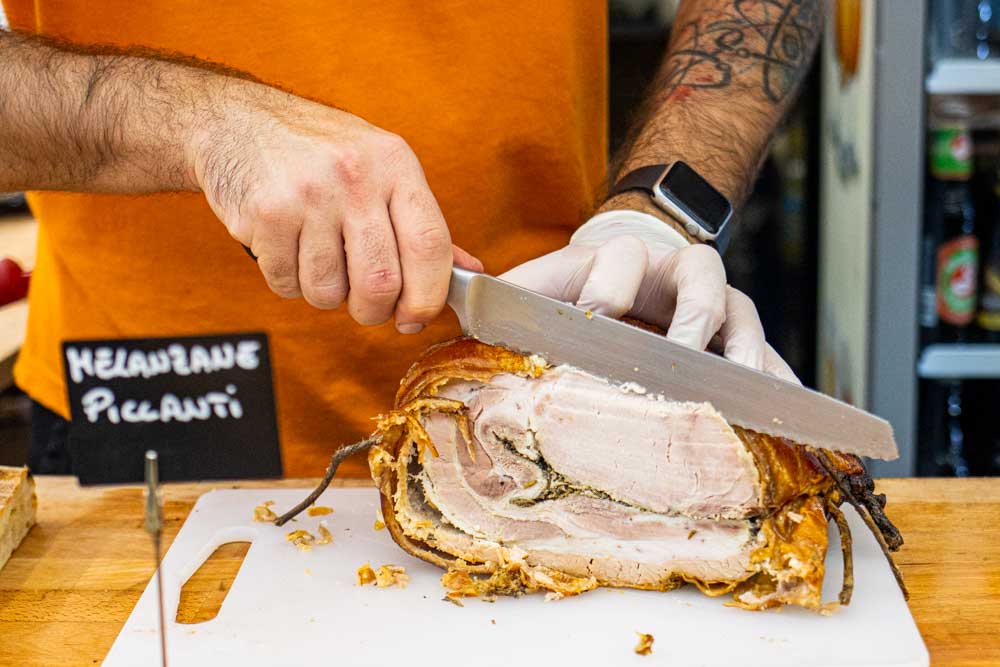

A specialty food around the world, porchetta is a readily available in Rome at food markets and sandwich shops. Romans can even find porchetta at street stalls and festivals.
This savory pork product rarely disappoints with its moist, herbaceous meat and crispy skin. Typical herbs include fennel, garlic and rosemary. Salt and pepper add the finishing touch.
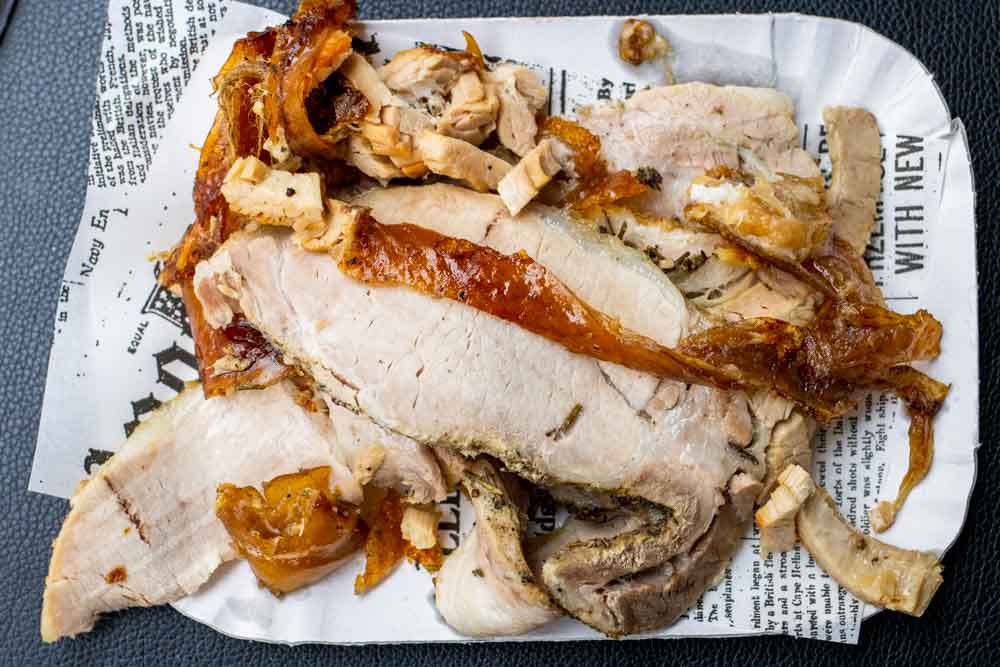

In many ways, porchetta sandwiches remind us of roast pork sandwiches we’ve eaten in our home city of Philadelphia. We consider that sandwich to be one of the best sandwiches in America. The connection makes sense considering that Philadelphia has a large number of residents with Italian heritage.
Where to Eat Porchetta in Rome
Er Buchetto, I Porchettoni and Il Norcino Bernabei
15. Fiori Di Zucca Fritti
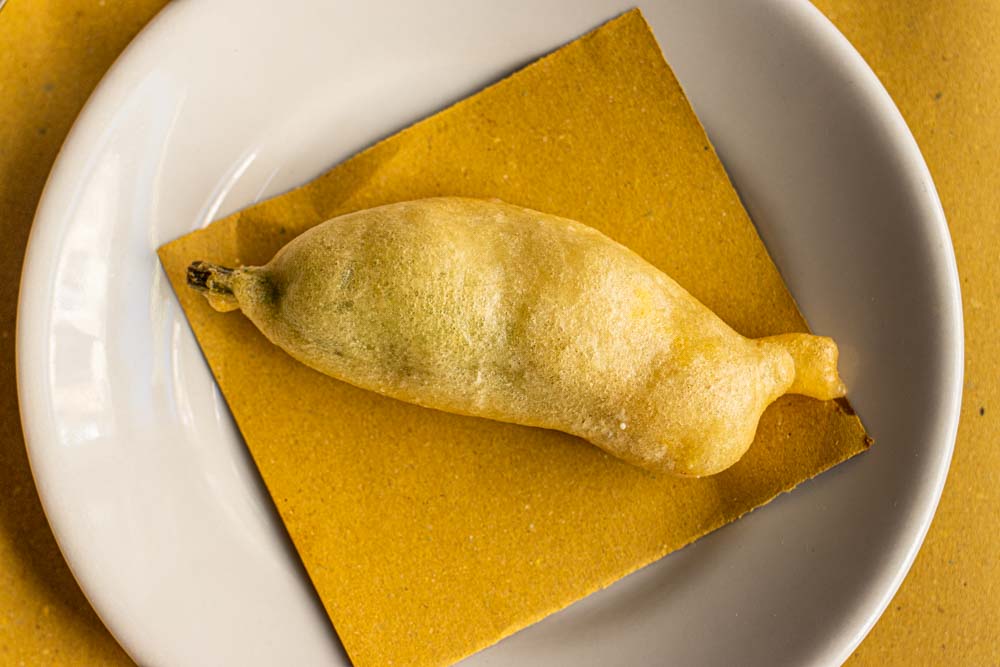

Naples may be the Italian hub for fried food, but Rome leads the pack when it comes to frying zucchini blossoms know as fiori di zucca.
Roman chefs follow several steps to to make fiori di zucca fritti. They prepare batter, separate zucchini flowers and dice provatura cheese. And that’s before anything hits the frying pan.
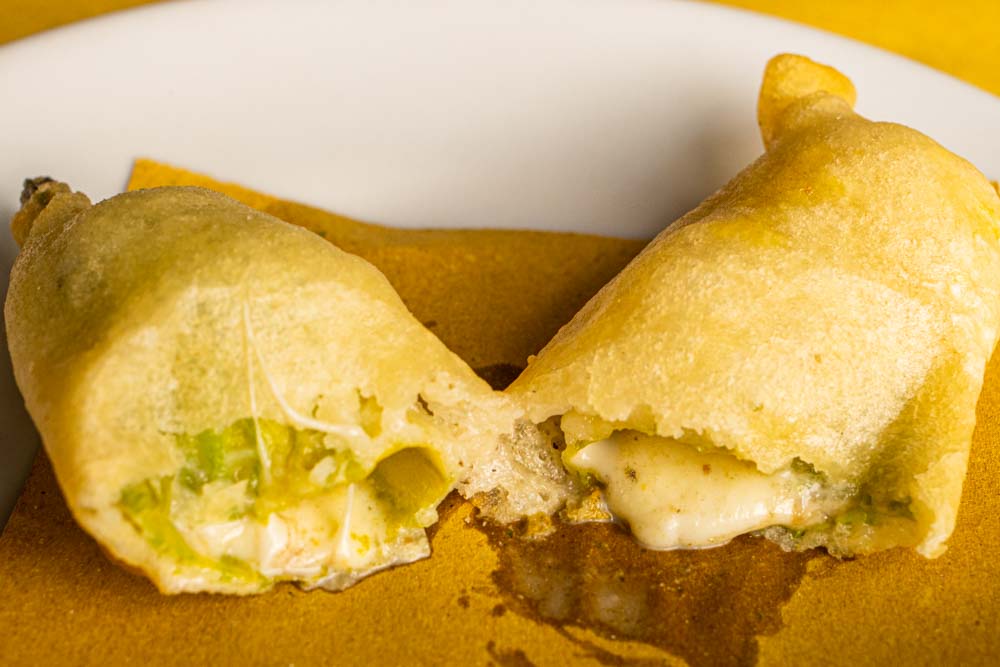

If you see fiori di zucca fritti on a Rome menu, order it. Since this delicacy isn’t available all year long, it’s a seasonal treat both for locals and travelers. Plus, ordering it is a heck of a lot easier than making this particular Roman food favorite from scratch.
Where to Eat Fiori Di Zucca Fritti in Rome
Restaurants like Piatto Romano
Local Roman Products
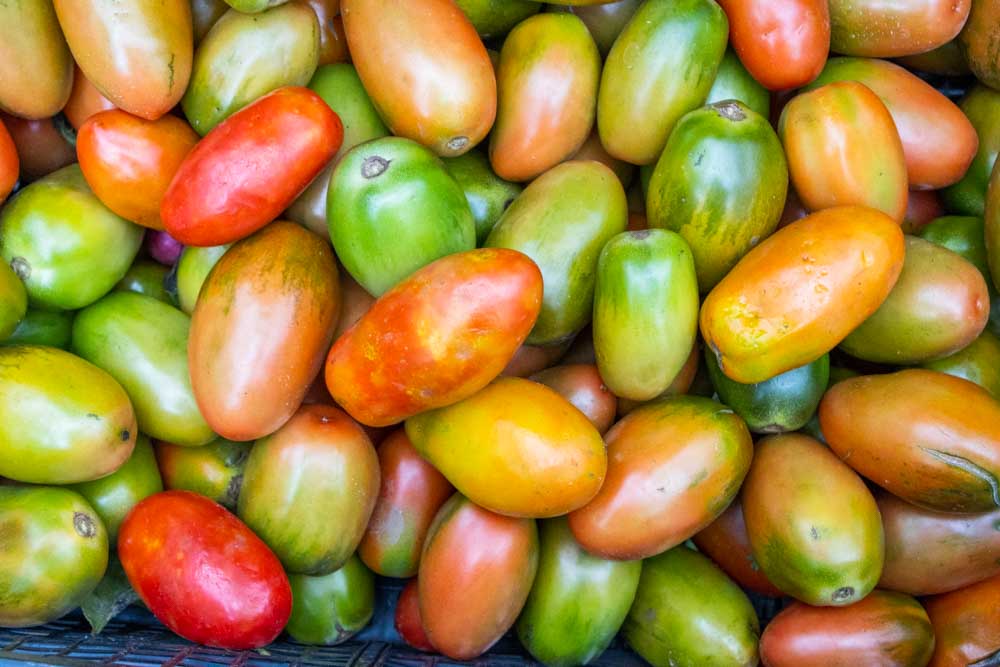

Shopping for local products in Rome is the opposite of boring. Shoppers can stock up at centrally located Campo de’ Fiori or at neighborhood markets like Testaccio and Trionfale.
However, we implore you not to skip local shops and supermarkets. You’ll be surprised at the quality and variety of products at chains like Conad and Coop. Plus, as a bonus, they sell wine and other potent potables.
Regardless of where you shop in Rome, be sure to look for the following local products:
16. Cured Meat
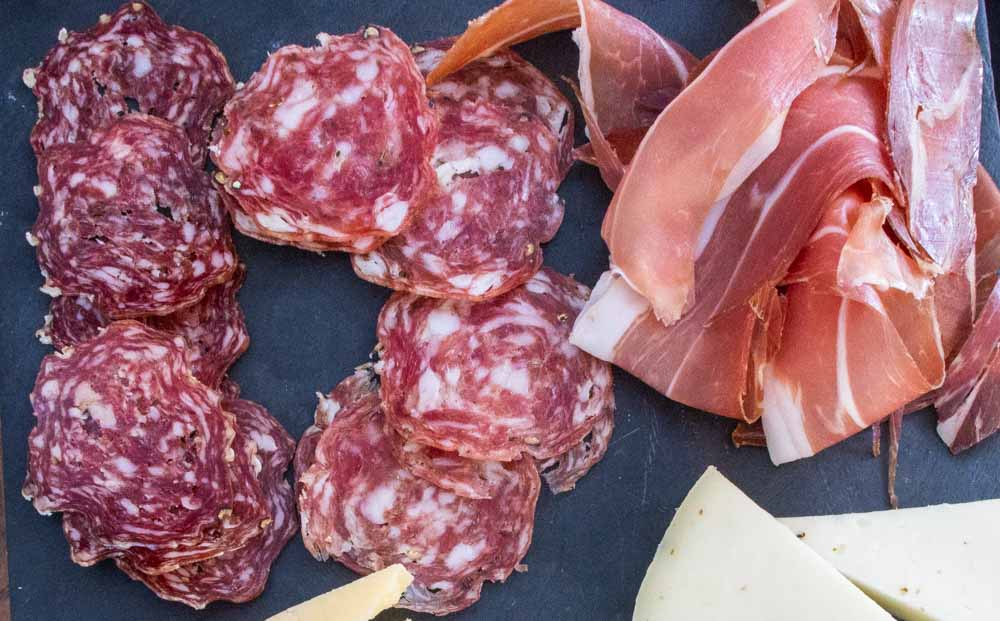

Italians have been eating salting and eating pork for centuries and it shows. The quality of cured pork throughout the country is second to no other country, though France, Portugal and Spain give the boot a run for its meaty money.
As as result, carnivores have an abundance of options when it comes to planning an aperitivo session in Rome. This is a city where it’s entirely possible to order a a ‘best of’ board topped with fennel-filled finocchiona from Tuscany, lush soppressata from Calabria and pistachio-prodded Mortadella from Bologna.
Where to Buy Cured Meat in Rome
Salumerias and Markets
17. Pecorino Romano
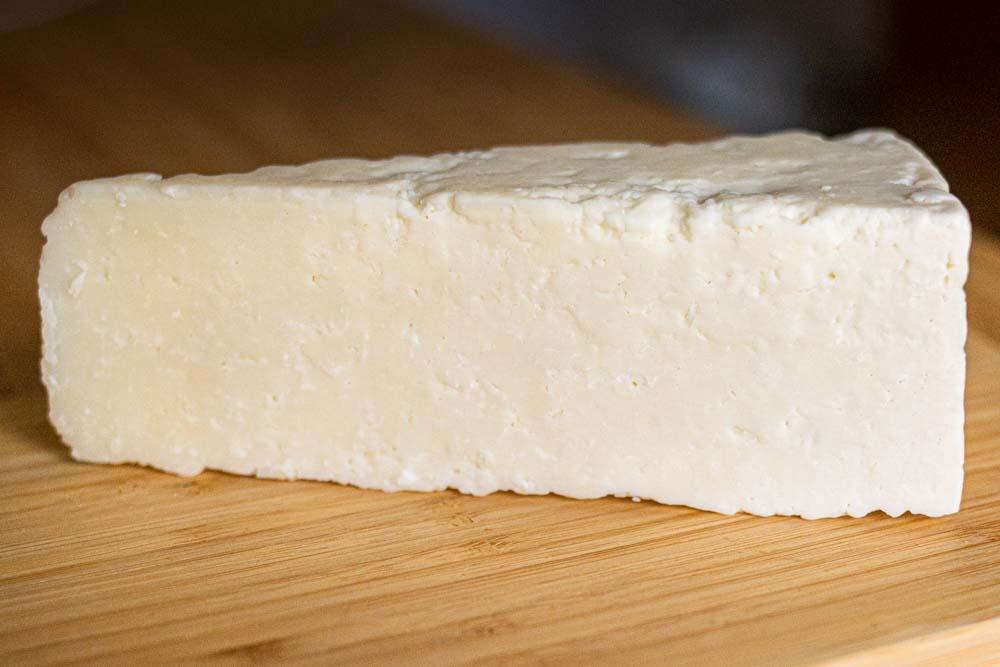

Pecorino Romano, Rome’s salty sheep milk cheese, is hard to miss in the Eternal City. Not only is it an integral ingredient in amatriciana, carbonara and gricia pastas as well as the most important item in cacio e pepe, but Romans also grate aged pecorino over dishes like trippe alla Romana and occasionally stuff it inside suppli.
This prevalence is nothing new or trendy in recent years.
Historians trace Roman production of pecorino Romano back two millennia. Although Sardinian producers like Locatelli sell much of the pecorino eaten in the United States, cheesemakers like Fulvi sell a DOP version available throughout the world.
Where to Buy Pecorino Romano in Rome
Specialty Shops and Markets
Roman Desserts
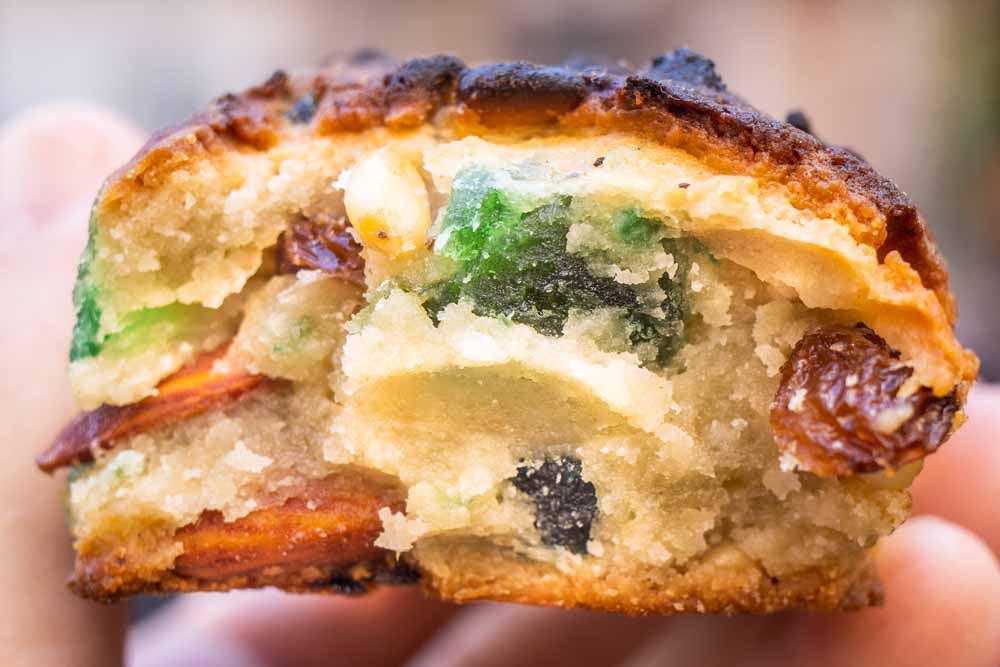

Many of the most famous Italian pastries have origins in Naples and Sicily while tiramisu hails from Treviso in northeastern Italy. Then there’s the croissant-like cornetto with roots in Vienna. Though it’s easy to find these desserts and more in Rome, we prefer to spend our calories on the city’s local creations.
Discover the best desserts around the world.
The following are our favorite Roman sweet treats and the ones you shouldn’t miss:
18. Pizza Ebraica
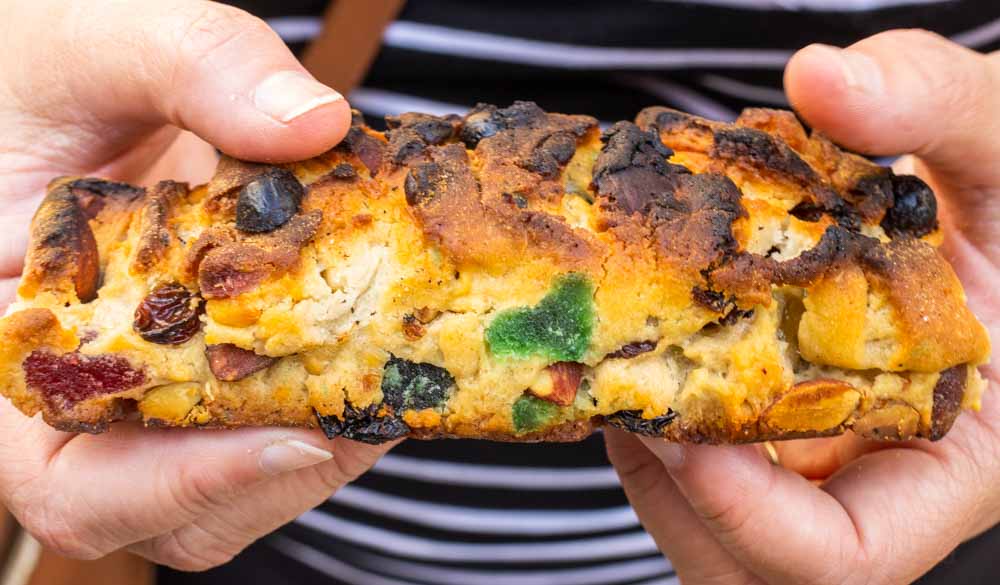

Pizza fans have their own dessert in Rome. Don’t worry – it doesn’t involve cheese, meat or herbs. Instead, pizza ebraica, i.e. Jewish pizza, gets its flavors from toasted raisins, nuts and colorful candied fruit.
After tasting pizza ebraica at Pasticceria il Boccione during our first trip to Rome, we were obsessed to eat it again during our most recent Rome food adventure. The Jewish Ghetto bakery was finally open on our third try, so we bought a ‘pie’ big enough for a delightful snack and breakfast the next day. Be warned – The bakery ladies will likely ask you to throw a euro in the Tzedakah cup – something we did, gladly.
Both savory and sweet, pizza ebraica was just as good as we remembered and maybe even better. Simultaneously sweet and savory, the hard, crunchy dessert reminds us of mandel bread on steroids.
Where to Eat Jewish Pizza in Rome
Pasticceria Boccione
19. Gelato
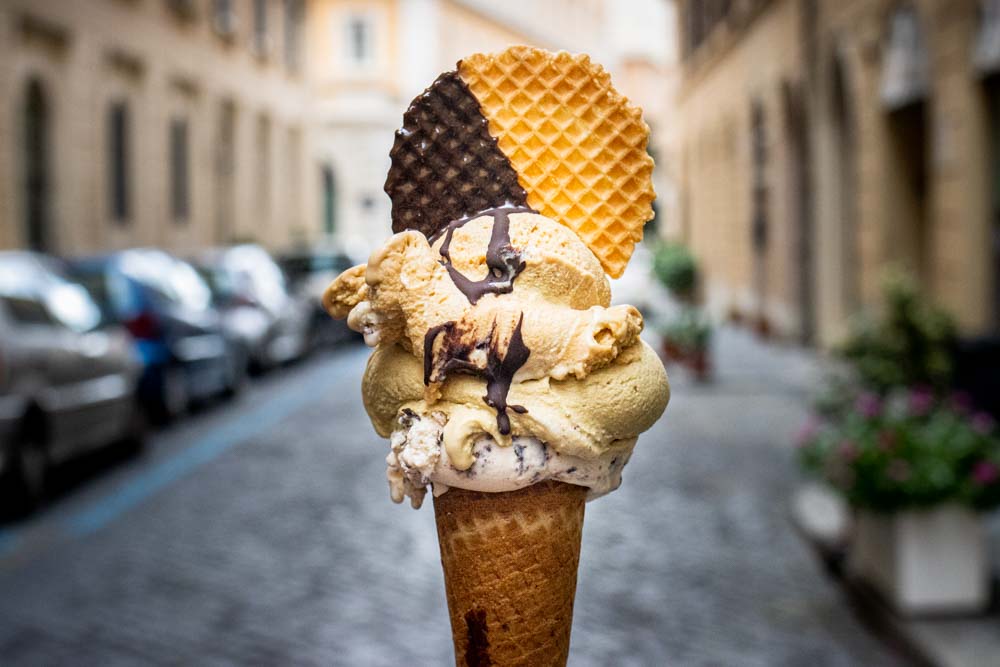

When it comes to gelato, the competition in Rome is fierce. For gelato aficionados like us, Rome gelato is on another level compared to Italian food cities like Florence, Naples, Venice and Verona. Bologna is a possible exception with gelato that rivals Rome’s sweet creations.
Discover the best Rome gelato shops.


We recommend skipping chains like Grom since you can eat their gelato in cities around the world. Instead, when in Rome, go to numerous local artisanal gelato shops and discover your favorites. That’s what we did.
Where to Eat Gelato in Rome
Gelaterias including Come Il Latte, FataMorgana Gelateria and Gelateria del Teatro
20. Maritozzo
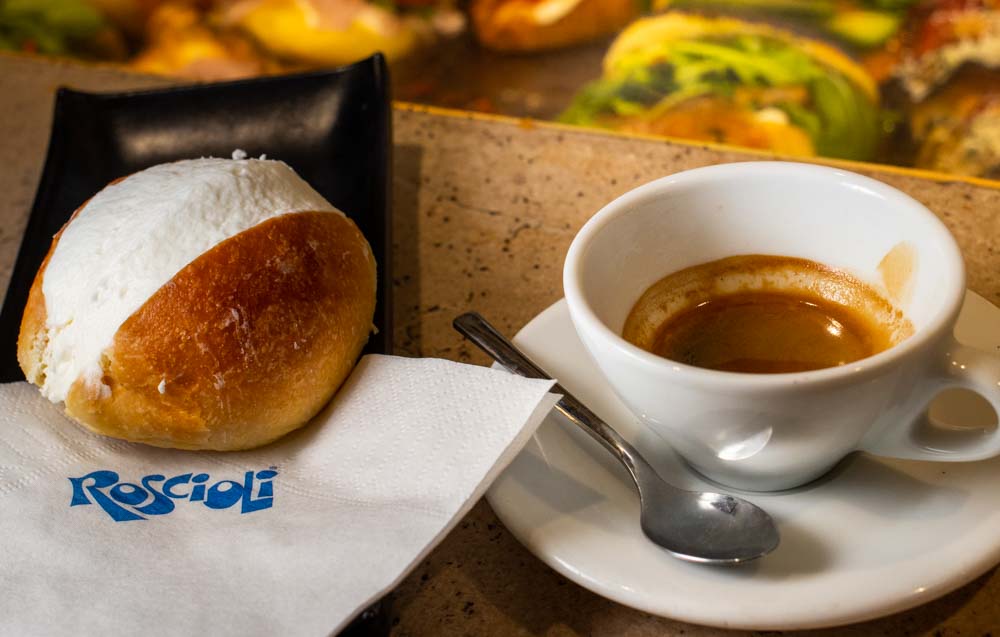

A maritozzo is essentially a brioche bun split down the middle and stuffed with whipped cream. What could be better than that? To us, the origin story is what makes this pastry special.
Pro Tip
Don’t skip eating a maritozzo if you’re not a dessert fan. Instead, order a savory maritozzo filled with cod or anchovies instead of sweet cream.
A local fixture for centuries, the maritozzo became part of Roman lore in the 19th century when suitors would present buns filled with cream… and a ring… to their intendeds in early March. Not coincidentally, the word maritozzo doubles as slang for husband.
Today, cafes serve maritozzi (plural of maritozzo) all over the city and some people take crawls in a quest to find the best maritozzi in Rome. They’ve gotten so popular that we’ve even spotted the Rome pastry in cities like Bergamo and Copenhagen.
Where to Eat Maritozzi in Rome
Pasticcerias and Caffès including Il Maritozzaro, Pasticceria Regoli and Roscioli Caffè
21. Torta Ricotta e Visciole
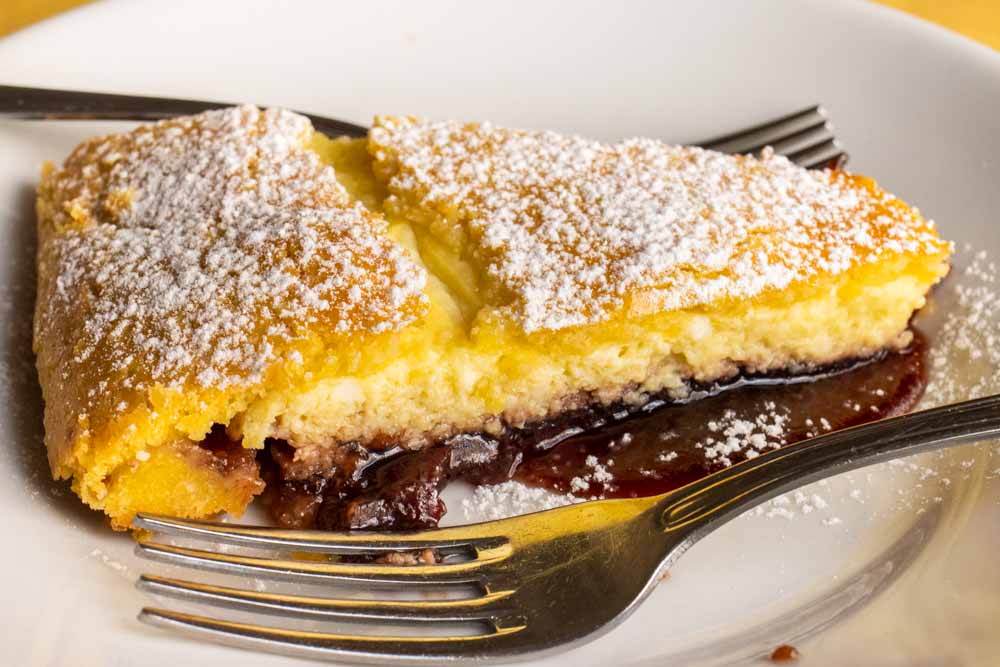

Pizza ebraica isn’t the only Roman dessert with Jewish roots. The torta ricotta e visciole, i.e. ricotta and sour cherry cake, is a second decadent delight with ties to the city’s Jewish quarter.
This cake combines sweet sheep’s milk ricotta and sour black cherries to create a dessert that’s satisfyingly sweet without being cloying. Plus, it pairs well with Roman after-dinner drinks like amaro and sambuca.
Where to Eat Torta Ricotta e Visciole in Rome
Pasticceria Boccione and Piatto Romano
22. Ciambelline al Vino
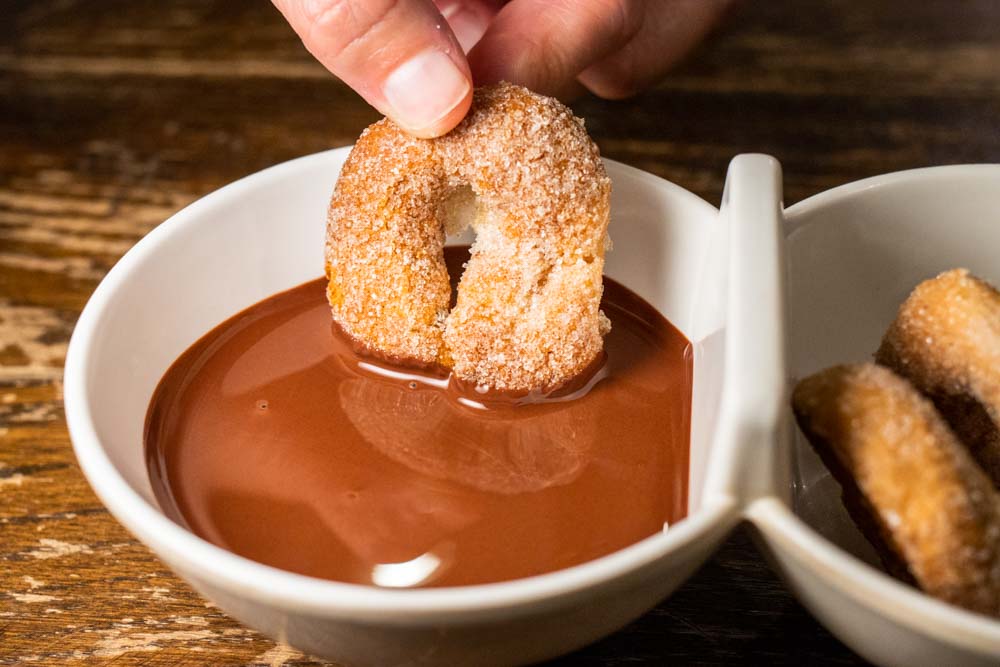

While Florentines enjoy eating cantuccini with vin santo, Romans don’t mess around with their cookies. Instead, they put the wine into their recipe along with pantry ingredients like flour, sugar and olive oil. The result are little ‘wine donuts’ called ciambelline al vino.
Most ciambelline al vino recipes are flexible and incorporate either white or red wine. Eating them is also flexible. While locals often dip the round cookies into wine, we dipped ours into chocolate sauce while enjoying glasses of wine – a true wine win.
Where to Eat Ciambelline al Vino in Rome
Roscioli Salumeria
Roman Drinks


Eating and drinking are intertwined in Rome from morning until night. This is a city where wine is not much more expensive than water and both flow freely at restaurants throughout the city.
Pro Tip
Order a bottle of water, either still or sparkling, when you dine at restaurants in Rome. Choose frizzante if you’re partial to fizzy water, leggiermente if you’re looking for barely fizzy water or naturale if you prefer flat water. We order frizzante.
Locals typically start their day by ordering coffee with their morning pastry before switching to wine and other libations as the day progresses. While some people order a Negroni or spritz to go with their aperitivo, many stick to wine produced throughout Italy and locally in Lazio. And then there’s craft beer and digestifs.
Since these drinks are key components of la bella vita (the good life), you’ll want to try all of them during your time in Rome.
23. Coffee
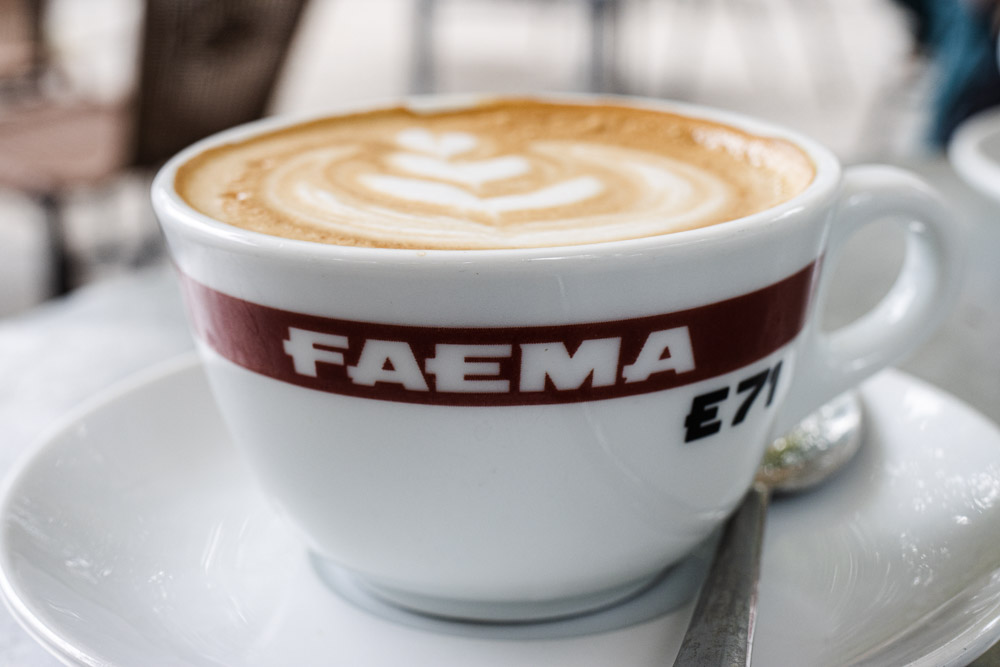

Italian coffee culture is legendary for its unwritten rules involving how and what to order. These rules even stipulate that it’s a no-no to order milky drinks like cappuccinos after 11 am. Whether or not you follow these rules is up to you.
Learn about the art of drinking coffee in Italy.
As for us, drinking little cups of caffè (i.e. espresso) at traditional cafes isn’t really our thing. We prefer drinking flat whites and pour overs at specialty coffee shops. Don’t get us wrong – we’ll happily drink old school Italian espressos in a pinch.
Finding the best coffee in Rome was a bit of a passion project for us. It was also a lot of fun.
Where to Drink Coffee in Rome
Local Caffès as well the excellent Specialty Coffee Shops featured in our Rome Coffee Guide
24. Wine
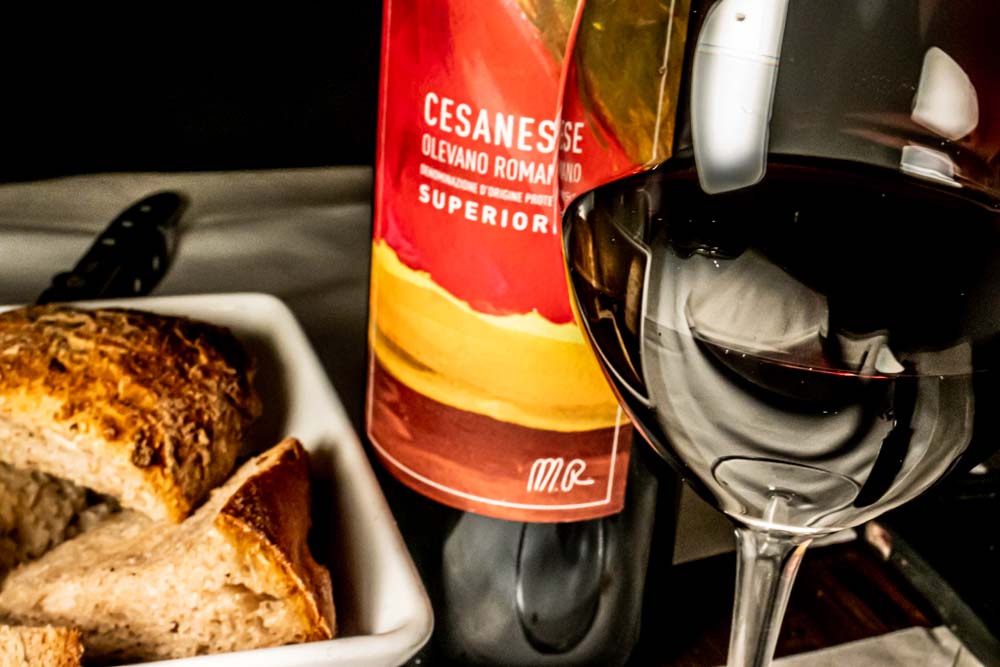

We like to drink the best local wine whenever we visit Italy. Not only does this approach provide a window into the region’s food scene, but it also provides us with tremendous wine values.
Following this approach, we were delighted to drink a bottle of locally produced Cesanese di Olevano Romano during our lunch at Roscioli Salumeria. Despite its value price, the rustic red provided a robust counterpart to our classic pasta dishes and motivated us to further explore the wines of Lazio.


We later found out that Roscioli has more than 60,000 (!) bottles of wine in its inventory. Varietals expand beyond Lazio with wines from regions like Piedmont, Sicily, Tuscany and the Veneto on the wine list. But, if you’re like us, you’ll want to order a local wine.
Now that we’re home, we’re continuing our wine tasting education via the Roscioli Italian Wine Club. We’re excited to get organic Italian wine delivered to our home along with tasting notes and tips.
Where to Drink Wine in Rome
Enotecas and Restaurants including but not limited to Roscioli Salumeria
25. Craft Beer
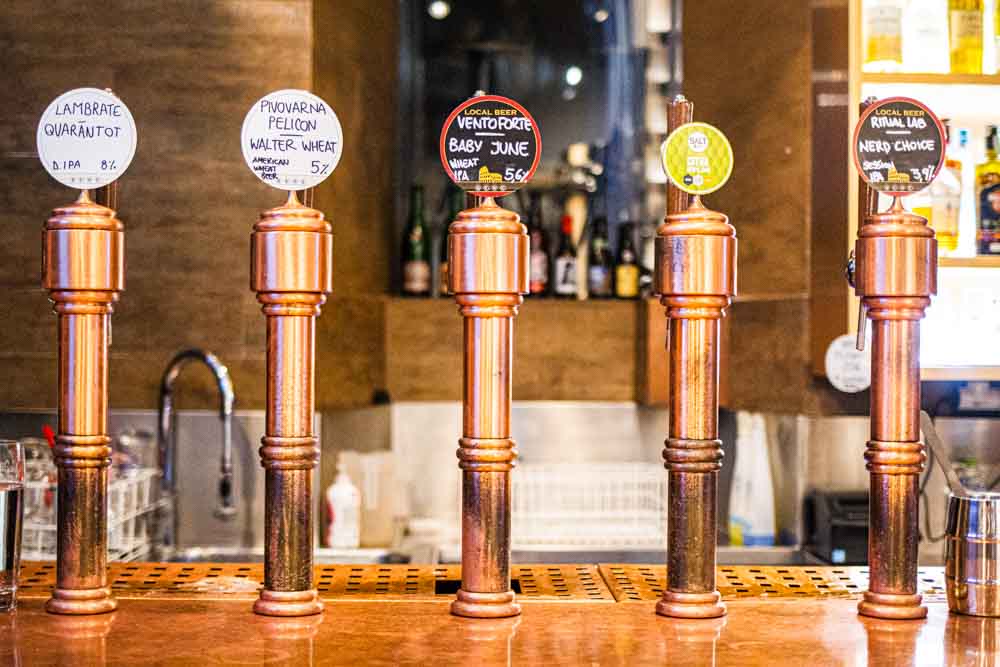

During our first trip to Rome, we were satisfied to drink Moretti and Peroni with our pasta and pizza. However, we’ve since become more particular with our beer drinking choices.
Luckily, Rome’s beer scene has evolved over the years to include a healthy number of independent brewers and craft beer bars. Piemonte Region brewer Baladin opened the brewpub Open Baladin in 2009, setting a high ‘bar’ for other brewers that followed.
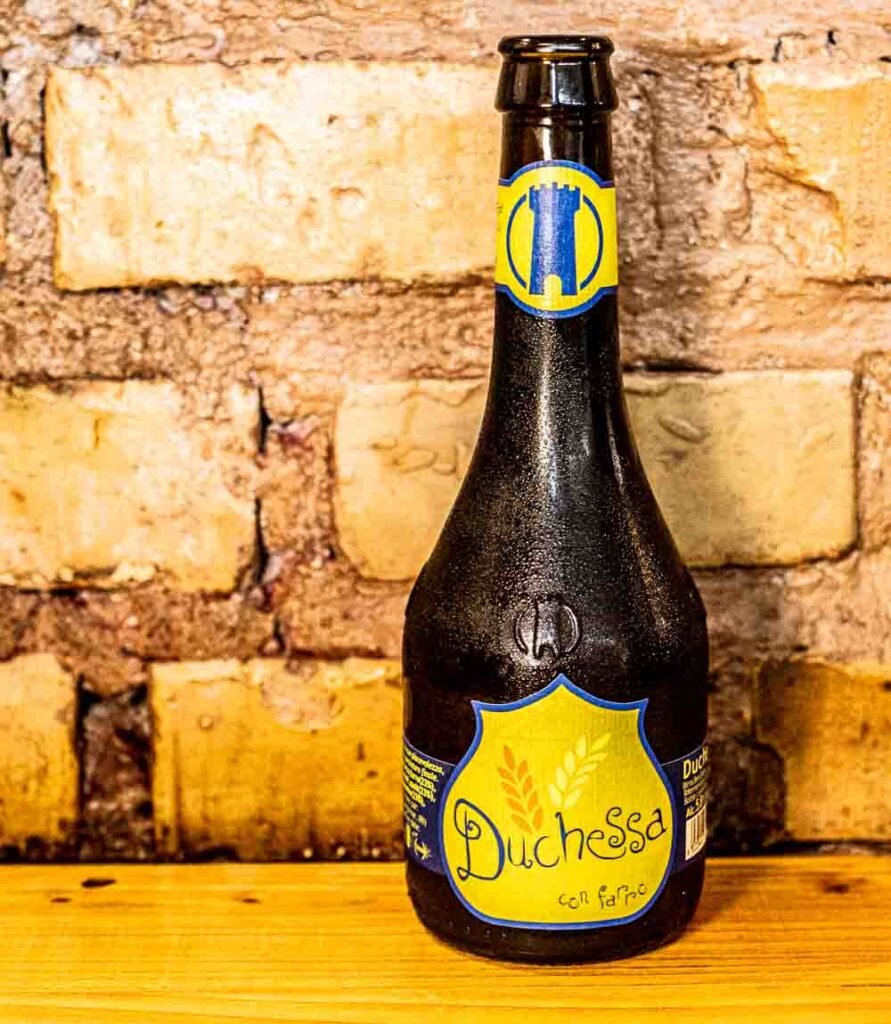

Bars and breweries aren’t the only venues that sell craft beer in Rome. We shared a bottle of Duchessa beer produced in Rome’s Borgo neighborhood during our dinner at Trapizzino.
Where to Drink Craft Beer in Rome
Casual Eateries like Trapizzino and Craft Beer Bars like Open Baladin
26. Digestifs


Rome is a city where the meal doesn’t end when the food is gone. As opposed to dashing out the door, diners linger while sipping an espresso or savoring a stronger libation.
Digestifs are a great after dinner drink option in Rome. Playing a double role, these drinks facilitate the digestive process while providing a tasty kick. Popular options include bitter amari, herbaceous bittters and sweet liqueurs.
Since sambuca is local to Rome, we recommend trying a shot of this liqueur made with anise seeds. Amalfi’s limoncello and Milan’s fernet branca are also solid options.
Where to Drink Digestifs in Rome
Enotecas and Restaurants
Useful Rome Facts
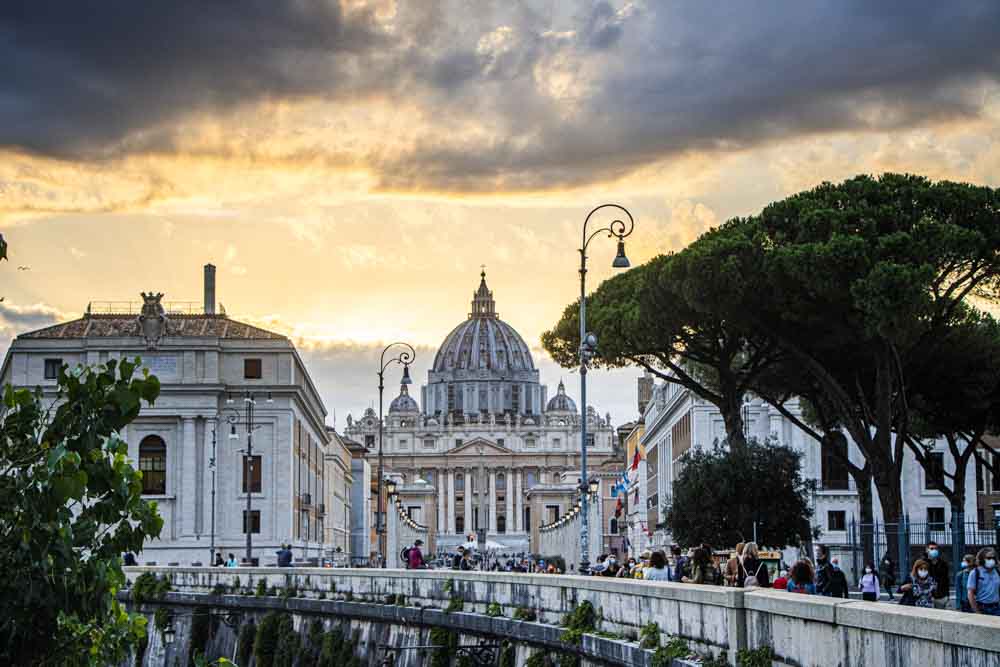

Frequently Asked Questions
Rome’s top foods are all pasta dishes – cacio e pepe, carbonara, amatriciana and gricia – and they’re all delicious. Not surprisingly, pizza is popular too.
Roman food has evolved over the centuries into a rich cuisine that transcends pasta and pizza. Typical Roman dishes include carciofi alla giudìa, trippa alla Romana and saltimbocca alla Romana.
The popular maritozzo is both easy to find and easy to eat in Rome. It’s basically a brioche bun split down the middle and stuffed with whipped cream.
Food in Rome is NOT expensive compared to similar European cities. When traveling to Rome, budget diners can’t go wrong at most pizzerias and trattorias.
No. Tipping is optional in Italy.
Anthony Bourdain visited Betto E Mary, Cacio e Pepe, Cafe Faggiani, Freni e Frizoni, Gelateria dei Gracci, I Porchettoni (permanently closed), Osteria dal 1931, Pizzarium, Ristorante Paris (permanently closed), Roma Sparita, Roscioli Salumeria con Cucina, Trattoria a Casa di Rita, Trattoria Il Timoniere, Trattoria Morgana, Trattoria Settimio, Trattoria Sora Lella, Vitti dal 1898 and Volpetti Salumeria while filming the sixth season of No Reservations, the first season of The Layover and the eighth season of Parts Unknown.
Stanley Tucci ate at Armando al Pantheon, Bistrot64, Bar San Calisto, La Reginella (permanently closed), Pommidoro and SantoPalato while filming the first season of Stanley Tucci – Searching for Italy.
People typically eat dinner between 7pm and 9pm in Rome.
Reservations are necessary at Rome’s’ better restaurants. However, you should be able to walk into pizzerias and snack shops though you may need to wait in a queue.
Video Recap
Check out our guide to eating in Italy as well as our picks for the best Italian foods and the best Italian desserts before your trip so that you don’t miss a delicious bite.


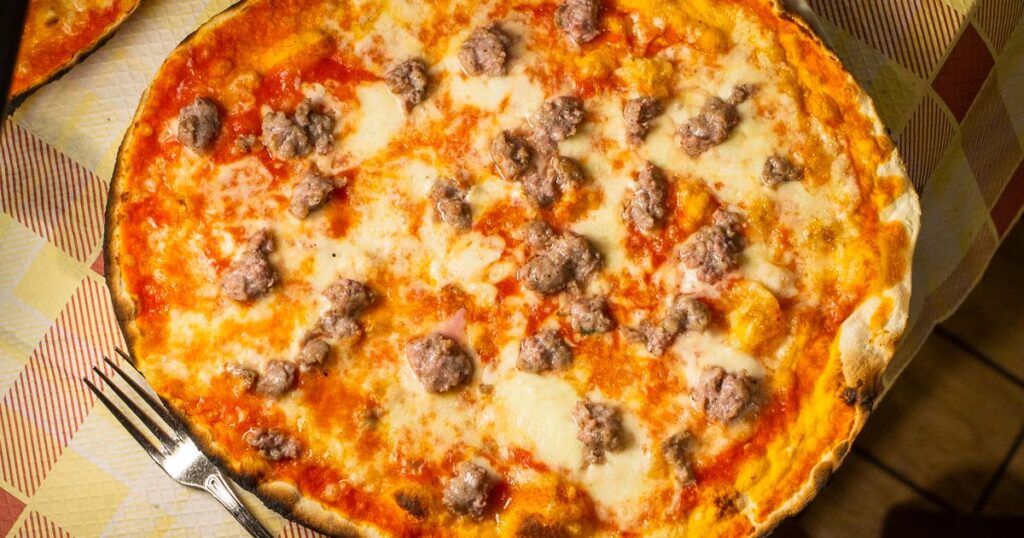
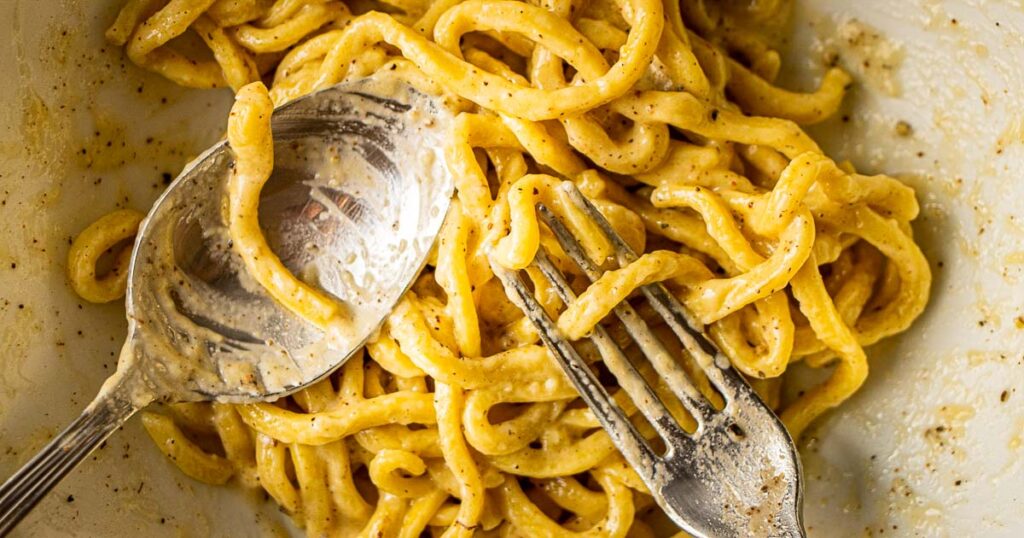
With regards to carbonara, how do you emulsify an egg without breaking the yolk?
When we speak about an egg breaking what we mean is the breaking of the proteins under heat like the way eggs break from liquid to solid when they’re scrambled. In carbonara, the art is heating the yolks to a viscous sauce with body (over heat) and not scrambling the eggs at the same time.
Thanks for reading.
Amazing! Loved it! Currently on a plane to Rome! Will use this advice soon!
Enjoy your time in Rome. It’s a wonderful city!
You know your shit i must say! I first found your guide for Napoli which i thought was quite good. However, being a skeptical man, I thought i should see what you write about Rome to get a better judgement if we have similar preferences for food. Result: I think your blog will be my default from now on when i visit a new city 🙂
Thanks so much Martino!!
Sorry it isnt good related but I am very worried about being robbed in Rome, do you have any tips for staying safe and not being targeted by pick-pocketers? I have been told its really bad
Make sure to place all your valuables in a secure place while touring such as a money belt or a neck wallet placed inside your garment. Always put your phone in safe, theft free place like a zipper pocket or hold it tightly. Be especially careful around heavily touristed zones like the pantheon, coliseum, Spanish steps or vatican. Also place all your valuables in a theft free place while on public transport. Last, carry a backpack that zips on the inside instead of the rear such as this one. It’s the backpack that we both use.
Have a fantastic time in Rome. It’s one of our favorite cities.
Currently in Roma making our way through as many of the 25 must eat items as we can! I have trusted your food advice for many years and know we’ll be eating and drinking well 😉
Enjoy every bite and sip!